#Sequence diagram parallel
Explore tagged Tumblr posts
Text
Chemistry Sem 4 End - Mod 4
Arrhenius eq
We know that the kinetic energy of a gas is directly proportional to its temperature.
Thus as the temperature of a system increases, more and more molecules acquire the necessary energy greater than Ea to cause productive collisions, This increases the rate of reaction.
In 1889, Arrhenius suggested as simple relationship between the rate constant, k, for a reaction and the temperature of the system:
formula
This is the Arrhenius equation where - A is an experimentally determined frequency factor - Ea is activation energy - K is rate constant - R is gas constant - T is Kelvin temperature
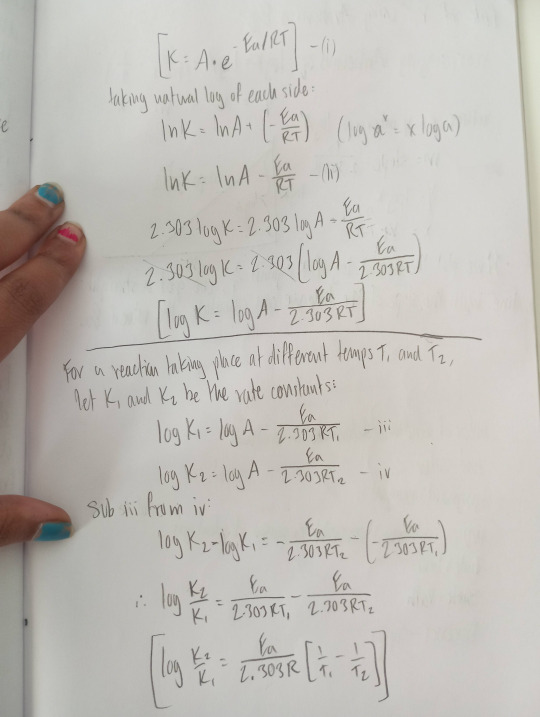
Arrhenius equation can be used to calculate the activation energy, Ea.
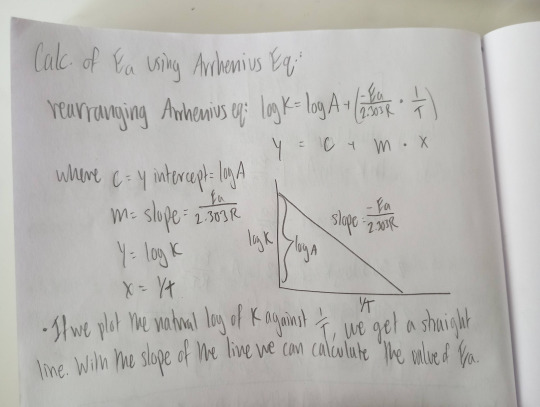
---
Rate constant eq for first order reaction, define order of a reaction
Order of a reaction is defined as the sum of the powers of concentrations in the rate law.
Consider the example of a reaction which has the rate law: rate=k[A]^m[B]^n The order of such a reaction is (m+n).
The order of a reaction can also be defined with respect to a single reactant, thus the reaction order with respect to A is m and with respect to B it is n.
The overall order of reaction (m + n) may range from 1 to 3 and can be fractional.
Reactions may be classified according to the order. If m+n = 1, it is first order reaction m+n = 2, it is second order reaction m+n = 3, it is third order reaction
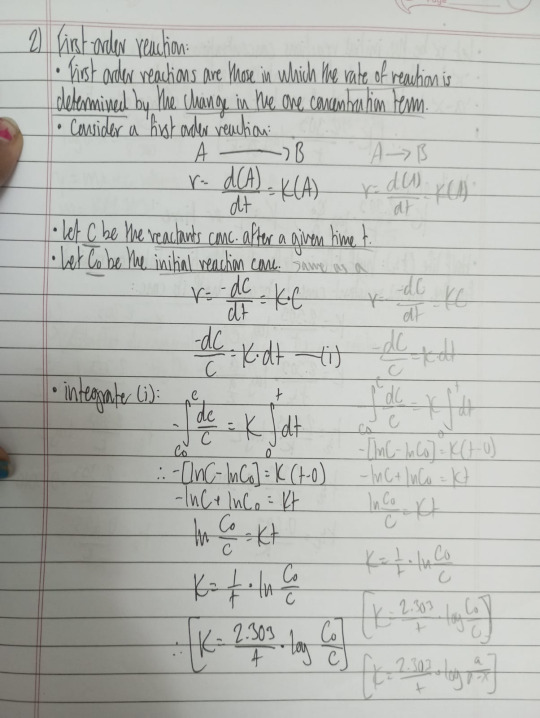
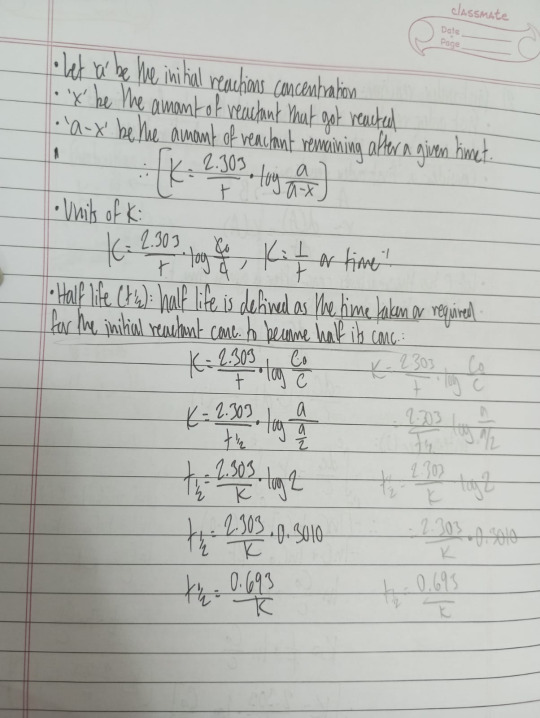
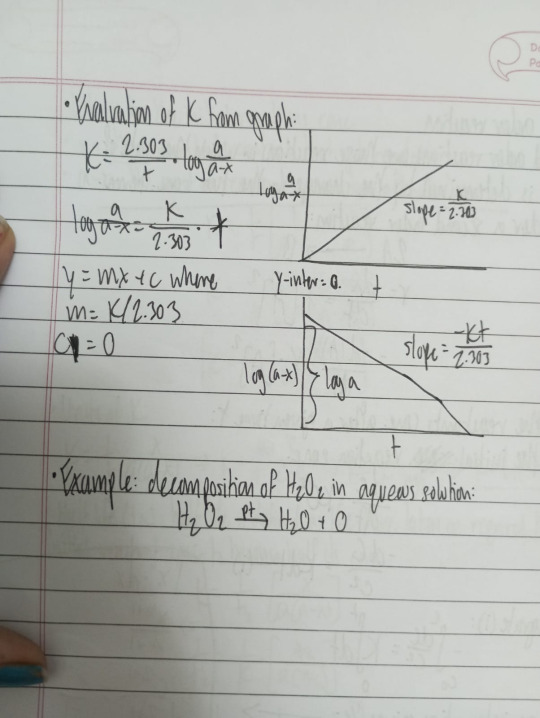
---
Jablonski diagram + explain phosphorescence, fluorescence, and ISC
According to Grothus-Draper law, only the light which is absorbed by a system can bring about a photochemical reaction.
The light absorbed may be re-emitted along in one or more steps. This phenomenon is called fluorescence. The emission in fluorescence ceases with the removal of light source.
Sometimes the light absorbed is given out slowly and even long after removal of light source. This is call phosphorescence.
The phenomena of both fluorescence and phosphorescence can be explained with Jablonski's diagram.
The quantity 2S+1 where S is the total electron spin in most of the molecules have even no. of electrons and all the electrons are spin paired, Here S gives Spin Multiplication.
If spins are paired (↑↓) unpaired orientation is cancelled by downward spin. therefore S=0 S1 = +1/2, S2 = -1/2 S = 1/2 - 1/2 = 0
Hence (2S+1) = 2x0+1 = 1 or singlet ground state
When absorption of photon of suitable energy hv one of the paired electrons goes to the higher energy level. The spin orientation of two single electrons may be parallel or antiparallel

If spins are parallel: S = phospherS1+S2 = 1/2+1/2 = 1 (2S+1) = (2x1)+1 = 3 Spin multiplicity of molecules is known as triplet excited state.
If spins are antiparallel: S = S1+S2 = 1/2-1/2 = 0 (2S+1) = (2x0)+1 = 1 Spin multiplicity of molecules is known as single excited state.
Since electrons can jump to any of the higher electronic states depending upon the energy of the photon absorbed, we got a series of singlet excited states: Sn where n=1,2,3,4,...
This S1, S2, S3, etc. are known as 1st singlet excited state, 2nd singlet excited state, 3rd singlet excited state, so on.
Similarly T1, T2, T3, etc. are know as 1st triplet excited state, 2nd triplet excited state, 3rd triplet excited state, etc.
Accordingly, energy sequence is as follows: ES1>ET1, ES2>ET2,etc
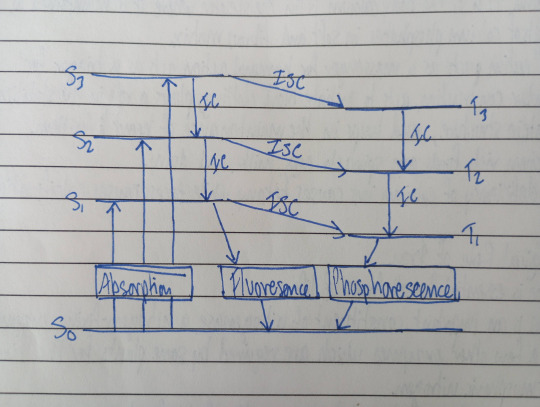
On absorption of light photon, the electron of the absorbing molecule may jump from: S0 -> S1 or S2 or S3 (Singlet excited state) depending upon the energy of light photon absorbed as shown in diagram.
For each singlet excited state (S1, S2, S3, etc) there is a corresponding triplet excited state (T1, T2, T3, eTc)
The molecule is said to be activated whether the singlet or triplet excited state A + hv -> A*
'A' molecule in the ground state on absorption gets A* excited state molecule (Activated molecule)
The activated molecule remains in the ground state by dissipating its energy through the following types of processes: - Non-radiative - Radiative
Non-radiative transitions
These transitions involve the return of the activated molecule from higher excited states to the first excited state. These reactions do not involve in the emission of any radiations and are this referred as non-radiative transitions.
The energy of activated molecule disappears in the form of heat through molecular collisions. This process is called Internal Conversion (IC)
The molecules also lose energy by another process called Intersystem Crossing (ISC)
ISC involves in transition between states of different spins and different multiplicity, ie: S2 -> T2 S1 -> T1
These transitions are also non-radiative spectroscopically, such transition are forbidden.
Radiative transitions
Fluorescence: (S1->S0)
The transition from the single excited state to ground state
Such transitions are accompanied by the emission of radiation. Spectroscopically the transition from S1 -> S0 is allowed and occurs in about 10^-8 seconds
The emission of radiation is this transition is called fluorescence.
Phosphorescence: (T1->S0)
The transition from the triplet excited state to ground state.
It is rather slow since it is a forbidden transition.
The emission of radiation in this transition is called phosphorescence.
The life times of phosphorescence are much longer being of the order of 10^-3 seconds or greater since the transition involves spin inversion which needs time for it's occurrence.
Both fluorescence and phosphorescence radiations are of shorter frequencies than existing light as some part of energy of molecule disappears in the form of heat during "non-radiative transitions."

---
Grothus-Draper principle of photochem activation
There are two basic laws of photochemical reactions - Grothus-Draper law - The Stark-Einstein law of Photochemical Equivalence
Grothus-Draper:
When light falls on a cell containing a reaction mixture, some light is absorbed and the remaining light is transmitted.
Only the absorbed component of light that is capable of producing the reaction, the transmitted light is ineffective chemically.
This is Grothus-Draper law and may be stated as follows:
When light falls on an object, a part of it is reflected and a part of it is transmitted. The rest is absorbed by the reacting system which is effective in bringing about a chemical change.
However, this does not mean that the absorption of radiation must necessarily be followed by a chemical reaction.
When the conditions are not favorable for the molecules to react, the light energy remains unused. It may be re-emitted as heat or light.
-
The Stark-Einstein law of Photochemical Equivalence
Stark and Einstein noted that each molecule taking part in a reaction absorbs only a single quantum or photon of light.
The molecule that gains one photon-equivalent energy is activated and enters into reaction.
They thus proposed The Stark-Einstein law of photochemical equivalence, which may be stated as:
In a primary photochemical process, each molecule is activated by the absorption of one quantum or radiation (one photon)

molecule ‘A’ absorbs a photon of radiation and becomes activated. The activated molecule A* then decomposes to yield B.
---
Quantum efficiency of the photochem combination of H2 and Cl2
Quantum yield or the quantum efficiency of a photochemical process is defined as the no. of molecules reacted or formed per photon of light absorbed.
∅ = no of molecules reacted/no of photons absorbed OR
∅ = no of molecules reacted/no of Einsteins of radiation absorbed
For product formation:
∅ = no of molecules of product formed/same two denominators ^
Is the 2nd law is correct, then quantum yield should be unity? but this is very rare.
The quantum yields may be as high as as 10^6 or as low as 10^-2 for several photochemical reactions.
-
Cause of high quantum yields:
When one photon is absorbed by molecules and it decomposes to form more than one product molecule then the ∅ of molecule is greater than 1 and is said to be high.
Hydrogen-chloride reaction is a good example of high quantum yield.
But before explaining, photochemical process has 2 steps:
1) Primary Process: It proceeds through absorption of radiation by molecule to form excited atom or molecule. - ex: A (molecule) + hv (photon) -> A* (excited molecule)
2) Secondary Process: The activated molecules may react with the other molecules to form product - Or, the activated molecule may emit the radiation of either the same or different frequency.
-
ex: HCl Reaction
This is a photochemical chain reaction
A mixture of hydrogen and chlorine is exposed to light of wavelength 4000Å or less than 480nm.
The hydrogen and chlorine react rapidly to form HCl.
This is followed by secondary reactions. 1) Cl2 + hv -> Cl + Cl - primary process 2) Cl +H2 -> HCl + H - secondary process 3) Cl2 + H -> HCl + Cl - secondary process 4) Cl + Cl -> Cl2 - secondary process - Step 1 is chain initiation - Step 2 and 3 are chain propagation - Step 4 is chain termination
The reason for higher quantum yield is one photon of light absorbed in step 1 forms large number of HCl molecules in steps 2 and 3, where in step 4 Cl atoms lose their excess energy and recombine at the walls of the vessel by chain terminating.
The number of HCl molecules formed for a photon of light is very high, as a result quantum yield of reaction varies from 10^4 to 10^6
---
zero-order kinetics
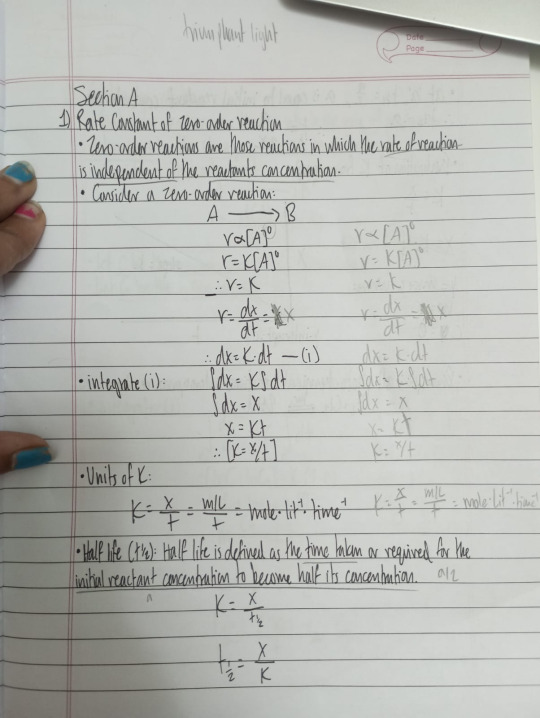
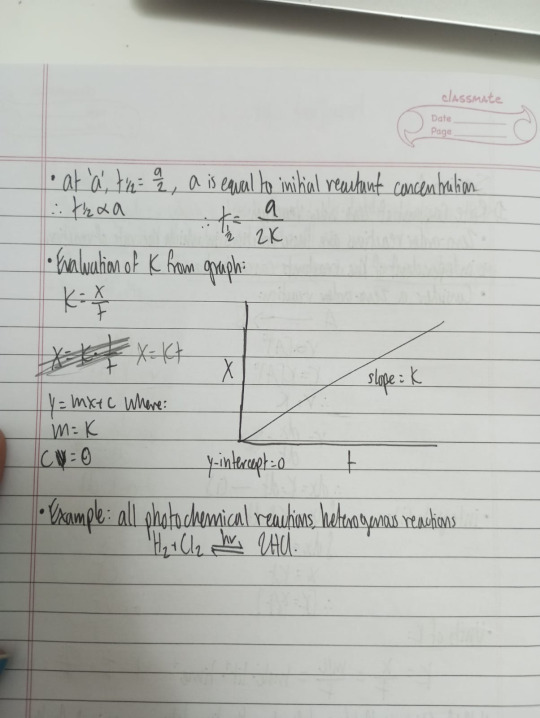
---
determine order of reaction w differential method
This method was suggested by van’t Hoff and, therefore, it is also called van’t Hoff’s differential method.
According to it, the rate of a reaction of the nth order is proportional to the nth power of concentration.
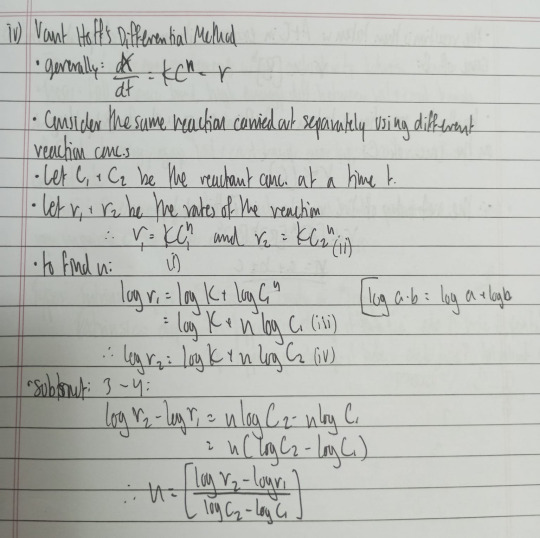
---
(5M) rate of reaction
The quantity of reactant species consumed on the quantity of product species formed in unit time in a chemical reaction is called the rate of reaction. A -> B
With the passage of time, the concentration of A goes on decreasing, while the concentration of B goes on increasing.
The rate of reaction at any moment may be expressed as follows: Rate of Reaction (ɣ) = amt of A consumed/time taken OR Rate of reaction (ɣ) = amt of B produced/time taken
If in a unit time, the amount of A consumed or B produced is large, the reaction is said to be a first order reaction.
However the rate of reaction cannot be determined by dividing the total change in concentration by total time taken, this is because the rates of reactions are not uniform.
Rate of reaction depends on the concentration of the reactant.
With the passage of time, the concentration of reactant species decreases progressively and hence the rate of reaction goes on decreasing.
Therefore, the rate of reaction at a given moment can be expressed by dividing the small change in concentration dx by small time interval Rate of reaction at a given moment = dx/dt
Hence the rate of reaction may be defined as: The instantaneous change in concentration of a reactant/product species at a given moment of time
Consider that change in concentration of the reactant species in an infinitesimally small time. Hence rate of reaction = dx/dt
1) If the rate is expressed in terms of the change in concentration of any reactants, there will be decrease in concentration with time. This, rate of reaction = -dx/dt
2) if the rate is expressed in terms of the change in concenreation of any one of the products, there will be an increase in concentration with time Therefore rate of reaction - +dx/dt
Units of Rate of Reaction: moles per liter per second
Factors affecting the rate of reaction - Nature of reactants and products - Concentration of reactants and products - Temperature - Surface area of reactants - Presence of a Catalyst - Light
1) Nature of Reactants:
Reaction between nitric oxide and oxygen is faster than the reaction between carbon monoxide and oxygen under the same conditions of temperature. NO(g) + 1/2O2(g) -> NO2(g) - fast CO(g) + 1/2O2(g) -> CO2(g) - slow
This is due to the difference in the nature of the reactants, that is NO and CO.
Since the bonds are broken and new bonds are formed in a chemical reaction, it seems reasonable that the rate of reaction should depend on the types of bonds involved.
2) Effect of Concentration:
The greater the concentration of reactants, the greater the inter-molecular collisions, and the greater the rate of reaction.
ex: A candle burns normally in air (20% O2) but burns more brightly in a jar of pure oxygen (100% O2) due do the higher concentration of oxygen.
3) Effect of Temperature:
Temperature has marked effect on rate of chem reaction. In most of the cases, the rate of reaction becomes double on triple for a 10°C rise in temperature
Large increase in reaction rate is due to the increase in the collision frequency and increase in effective collisions which can bring about a chemical change.
4) Effect of Surface Area:
Powdered sugar dissolved more readily in water than a crystalline sugar, This is because in the case of powdered sugar, more of it's surface area comes in contact with water in comparison to crystalline.
Similarly, powdered charcoal burns explosively in air while large pieces of coal burn slowly.
Thus, surface area of reactants in contact is an important factor for rate consideration.
5) Effect of Catalyst:
Rate of reaction may be increased by adding a suitable catalyst.
Inhibitor hinders the catalyst action while promoters increase the activity of the catalyst.
A catalyst takes part in the reaction. It is consumed in one step and regenerated in the subsequent step.
It is believed that a catalyst somehow provides a new path to the reaction.
6) Effect of Light:
The rates of certain chemical reactions are greatly influences by the light or radiations.
Absorption of light may exercise or energize a reacting molecule.
Sometimes, the molecules are broken down into more reactive intermediates.
---
(5M) Diff thermal + photochem processes
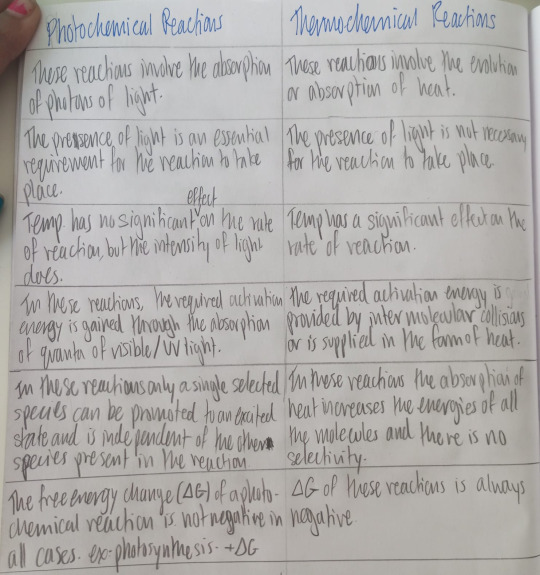
---
(5M) Activation energy
We know that for each reaction a certain energy barrier must be surmounted.
The reactant molecules must possess the activation energy, Ea, for the reaction to occur.
The catalyst functions by providing another pathway with lower activation energy, Ecat.
Thus a much larger number of collisions becomes effective at a given temperature.
Since the rate of reaction is proportional to effective collisions, the presence of a catalyst makes the reaction go faster, while all other conditions remaining the same.
It may be noted from the diagram that although a catalyst lowers the activation energy, the energy difference, ΔE, between products and reactants remains the same.

---
2nd order reaction

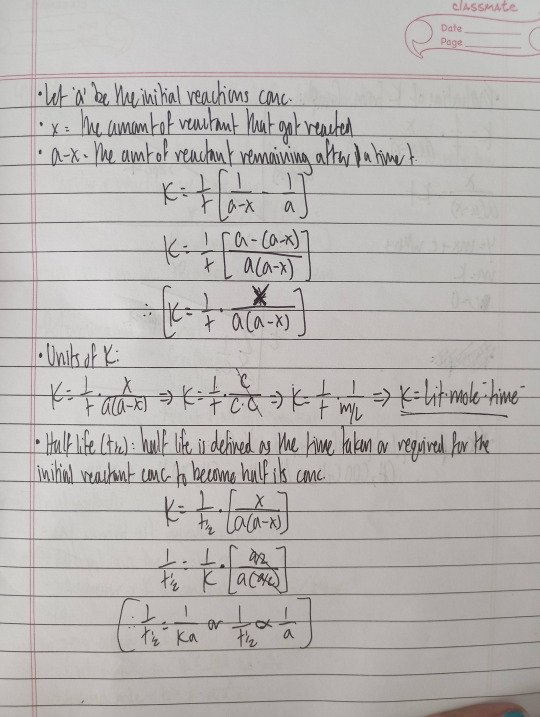
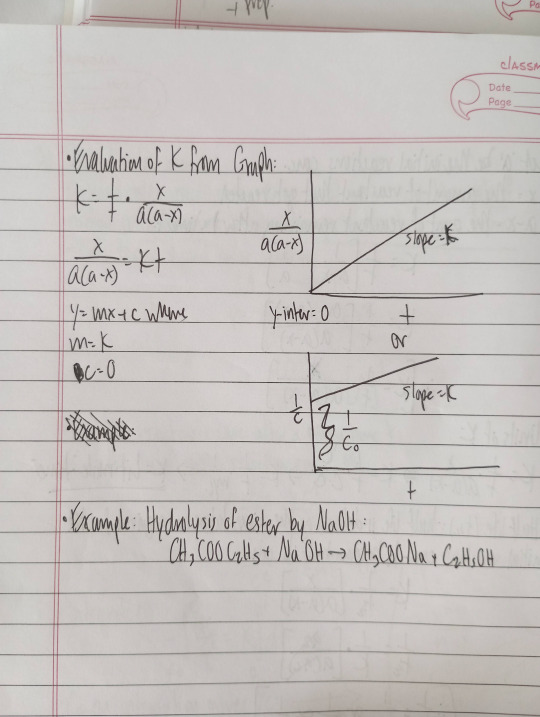
---
Methods for Determination of Order of Reaction
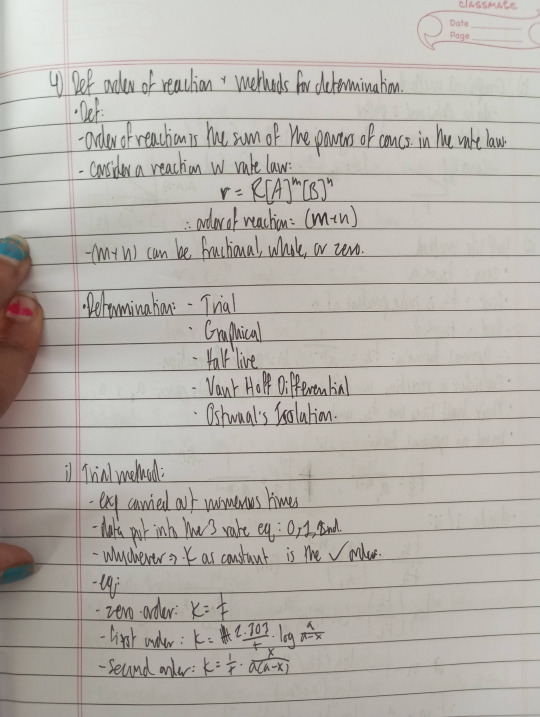

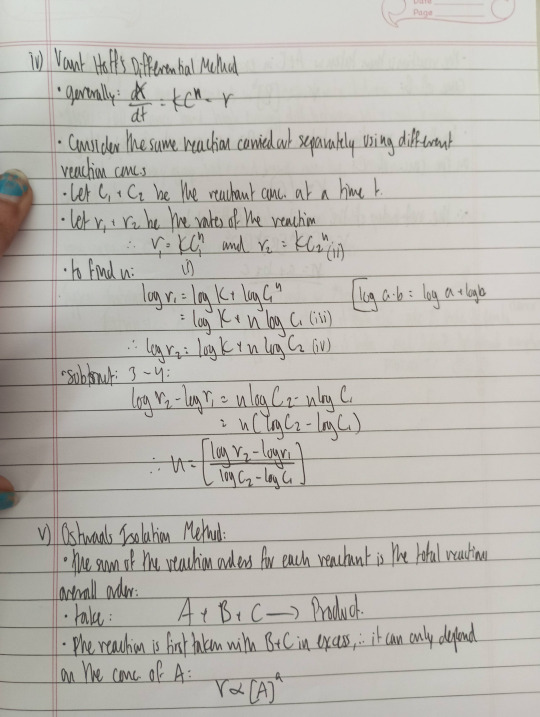
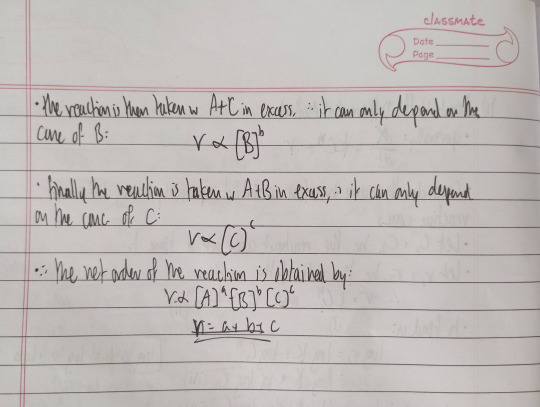
#exam season#notes#science#send help#long post#long reads#chemistry#physical chemistry#physics#chemical kinetics#photochemistry
0 notes
Text
Resource Constraints in Project Management: How Resource Leveling and the Parallel Method Can Save Your Project
In the world of project management, one of the most common challenges that organizations face is resource constraints. Even the most meticulously planned project schedules, drawn from a network diagram, can falter when the availability of resources falls short. This is where resource-constrained projects come into play, and understanding how to manage these constraints becomes key to project success.
But what exactly are resource-constrained projects, and how can we resolve the challenges they pose? This is where the concept of resource leveling, particularly the Parallel Method, becomes a game-changer. In this post, I’ll dive deep into these concepts, explore how they help manage resource constraints, and examine the impact on the project schedule and budget.
What Are Resource-Constrained Projects?
A resource-constrained project occurs when the resources needed to complete tasks are limited or fixed, regardless of the project’s schedule. This could be due to limited manpower, equipment, or budget—resources that cannot exceed a specific amount, regardless of the logical order of tasks. While tasks may be perfectly sequenced in a network diagram, the resource constraint can force a project to extend its timeline or, worse, cause bottlenecks that disrupt progress.
The Parallel Method: Balancing Resources Without Losing Momentum
The Parallel Method of resource leveling is one of the most effective strategies for managing resource-constrained projects. It works by re-sequencing tasks in a way that helps balance resource usage while maintaining the project’s logical flow. Let’s break down how this method works:
List Activities by Priority: In a resource-constrained environment, tasks with higher dependencies or those that need to start sooner are prioritized. This ensures that critical tasks are addressed first.
Adjust Based on Resource Availability: If multiple tasks require the same resource at the same time, one of the tasks may be delayed until the resource becomes available. Instead of adding new resources, this method redistributes the available resources to maintain flow and efficiency.
Maintain Logical Integrity: Even though the project schedule may need adjustments, the logical dependencies between tasks are preserved. This ensures that the integrity of the project timeline is not compromised.
By using the Parallel Method, project managers can effectively reduce overburdening of resources, avoid burnout, and ensure the quality of work. However, the trade-off is that resource leveling often extends the project schedule.
The Impact on the Project Schedule
When you implement resource leveling, the immediate impact is a change in the project schedule. For example, if two tasks require the same resource, and one task is delayed, the dependent task will naturally follow suit. This leads to a longer project timeline.
While extending the project duration may seem like a setback, it actually helps in preventing resource overload, mistakes, and inefficiencies that could arise from squeezing too much into too little time. It’s a crucial balancing act to ensure the project is still completed successfully.
Post-Leveling Schedule and Baseline Budget: The Cost of Adjustments
When the project schedule is adjusted due to resource leveling, it has direct implications on the project’s budget. The relationship between the post-leveling schedule and the baseline budget is crucial for understanding how the cost structure is affected. Here’s how the leveling process can influence both:
Impact on Costs: A longer schedule can lead to increased costs in several areas:
Labor Costs: If the project takes longer than planned, labor costs may rise. For example, if a team needs to work for extra weeks, their salaries or hourly wages increase.
Operational Costs: Similarly, extended timelines can result in additional overheads, like rental fees for equipment or software.
Cash Flow Adjustments: A delayed schedule shifts the timing of expenses. What was originally expected to happen within a short time frame might now be spread out over a longer period, impacting the organization’s cash flow projections.
Baseline Budget Revisions: The baseline budget, which was originally set to cover the planned timeline, may need to be adjusted to account for these new costs. If the project duration increases significantly, the budget must be updated to reflect the additional expenses, which could be substantial.
However, it’s important to note that while leveling the schedule may increase costs, it can also prevent more significant, hidden costs that arise from errors or resource mismanagement. Essentially, you might be trading a sprint for a marathon, but this longer run can be far more sustainable and cost-effective in the long run.
Final Thoughts
Resource-constrained projects are a reality that every project manager must face. The Parallel Method of resource leveling offers a practical way to manage resource limitations without compromising the integrity of the project’s logical structure. While it may result in a longer timeline, it ensures that resources are used effectively and that the project is completed successfully.
By understanding the impact on the post-leveling schedule and baseline budget, project managers can anticipate the financial and scheduling implications of resource leveling. In the end, it’s not just about sticking to the original schedule; it’s about adapting to real-world constraints while keeping the project on track.
So, the next time you encounter a resource-constrained project, remember the Parallel Method. It might stretch your timeline, but it will keep your resources—and your team—on track for a successful completion.
0 notes
Text
Blockchain, Bacon, and Bewilderment: The Unexpected Journey of John Locke
As I sat in my study, quill in hand and parchment spread before me, I found myself contemplating the profound intricacies of society, governance, and the nature of man. My thoughts, as they often did, wandered through the labyrinth of human understanding, when suddenly, the smell of sizzling bacon wafted through the air, rudely interrupting my reverie.
Now, you might wonder, dear reader, how the aroma of breakfast could possibly lead to an essay on blockchain technology. Well, let me regale you with the curious sequence of events that transpired.
It all began one foggy morning when I decided to take a respite from my usual contemplations and venture into the kitchen. My dear friend, Sir Roger Bacon, known not for his culinary prowess but for his ceaseless quest for knowledge, was attempting to cook breakfast. As you can imagine, the scene was a delightful chaos—bacon burning, eggs precariously perched on the edge of the skillet, and Sir Roger himself, covered in flour, muttering something about alchemical reactions and the transformation of base ingredients.
"John," he exclaimed upon seeing me, "do you know that the key to perfect bacon lies in the precise control of heat and timing? Much like the principles of alchemy!"
I couldn't help but chuckle at his enthusiasm. "Roger, your bacon is less a testament to alchemy and more a proof of chaos theory," I replied, rescuing the charred remnants from the pan.
As we sat down to enjoy our imperfect breakfast, Sir Roger's words lingered in my mind. The idea of control, precision, and transformation struck a chord. It was then that Sir Roger, in his boundless curiosity, began to speak of a newfangled concept he had encountered in his readings—a digital phenomenon called "blockchain."
"Imagine," he said with a twinkle in his eye, "a ledger that records transactions in an immutable chain, decentralized and transparent. It is as if every person in a village had a copy of the same record book, and no single book could be altered without the consensus of all."
His description, though laced with the usual dramatic flair, intrigued me. A system that promised transparency and trust without the need for a central authority? It echoed the very principles I had long espoused in my writings on governance and the social contract.
Fueled by a combination of curiosity and burnt bacon, I delved into the study of this "blockchain." I discovered that it was indeed a fascinating blend of cryptographic ingenuity and decentralized philosophy. The more I learned, the more I saw parallels with my own work—how blockchain's immutable ledger resembled the indelible rights of man, and how its decentralized nature mirrored the ideal of a society governed by the collective will rather than the whims of a despot.
In the weeks that followed, my study became a veritable hub of activity. Scrolls of ancient texts lay side by side with diagrams of digital ledgers, and my quill danced across the parchment as I sought to distill my newfound understanding into words. Sir Roger, ever the enthusiastic collaborator, often burst into the room with fresh insights or, more often, more burnt bacon.
One particularly memorable evening, as we pored over a particularly complex passage about cryptographic hashing, Sir Roger exclaimed, "John, this is it! The ultimate marriage of philosophy and technology! You must write about this!"
And so, dear reader, it was that a philosopher, a would-be alchemist, and a series of kitchen disasters led to the creation of an essay on blockchain technology. The immutable ledger of liberty, as I have come to call it, is not just a marvel of modern innovation but a testament to the enduring quest for a society built on trust, transparency, and the inalienable rights of man.
Thus, with a heart full of curiosity and a belly full of slightly overcooked breakfast, I present to you my essay on blockchain technology. May it inspire you to explore the intersections of the old and the new, the philosophical and the technological, and perhaps even to ponder the profound questions of our time—preferably over a plate of perfectly cooked bacon.
#blockchain#blockchain technology#technology#decentralization#tech#learning science#science#education#science education
0 notes
Text
Exploring the Techniques of Data Visualization

Large data sets need in-depth analytics and processing power to manage. This is where data visualization is helpful. Data visualization services have advanced rapidly in recent years, anticipated to alter the business environment shortly.
Data visualization utilizes visual elements such as charts, graphs, and maps to facilitate the observation and comprehension of trends, outliers, and patterns in data. It helps determine which variables to include or discard in the analysis.
This blog on data visualization techniques will provide detailed insights into the techniques and benefits.
What is Data Visualization?
Data visualization is a captivating form of visual art that captures our attention and effectively conveys a message. When we look at a chart, we can easily identify trends and outliers. Visualizing data allows us to quickly internalize information. It's essentially storytelling with a purpose. If you've ever struggled to identify a trend in a large spreadsheet of data, you understand the power of visualization.
Data visualization is a powerful method to explore data and present results effectively. Its primary use is in the pre-processing stage of the data mining process. It supports the data-cleaning process by identifying incorrect and missing values.
Techniques of Data Visualization
Representing visual data requires various techniques that must be followed to achieve this process. Let's explore some of these techniques to make this process simpler and easier.
1. Temporal
Temporal data visualization offers the advantage of familiarity, as we are already accustomed to using such visuals, particularly in educational and professional settings where charts are commonly used for explanations. Linear and one-dimensional data visualizations play a crucial role in temporal data visualization. Examples of temporal data visualizations include linear graphs, polar area diagrams, scatter plots, time series sequences, and timelines.
2. Multidimensional
Multidimensional data visualizations, as their name implies, involve multiple dimensions, typically requiring at least two variables for a 3D data visualization. These visualizations often feature vibrant and striking graphics due to the numerous concurrent layers and datasets. They excel at condensing large amounts of information into key points. Examples of multidimensional data visualizations include histograms, scatter plots, pie charts, Venn diagrams, and stacked bar graphs.
3. Geospatial
Geospatial or spatial data visualizations involve overlaying different data points on familiar maps to connect them to specific geographic locations. Examples of geospatial data visualizations include Cartograms, Heat maps, Flow maps, and Density maps.
4. Network
Users of network data visualization can demonstrate connections between different data sets. Within this network, communication takes place via intricate connections linking one data set to another. Visualizations such as alluvial diagram charts, parallel coordinate plots, node-link diagram charts, word cloud plots, network diagram charts, non-ribbon chord diagram plots, and matrix charts are commonly used to illustrate the relationships between data sets.
5. Hierarchical
When information needs to be organized into clusters, hierarchical data visualizations are very helpful. However, creating these graphs is more complex compared to other forms of visualization. Hierarchical data visualizations can show a company's or organization's data and object hierarchy. Examples of hierarchical data visualizations include ring charts, sunburst diagrams, and tree diagrams.
Wrapping Up
Data visualization solutions are an essential step in data processing techniques. In the new era, data visualization is making its debut. With the introduction of next-generation technologies and the development of apparent frameworks, it is moving from art to science, opening up new opportunities.
Using the above guide, you can use data visualizations for processing your business data or use the help of data visualization consulting services. A leading data visualization company excels at this situation and can help you to implement this approach. There is a plethora of legacy modernization services available to modernize your business applications. To make data-driven decisions, choose top-quality data visualization services to create a data visual model.
0 notes
Text
How does binary logic work? Shift registers

Sometimes, a microcontroller does not have enough pins to receive signals from buttons or display them on LED indicators, control relays, etc.
Sometimes, one needs to interconnect two digital devices with a single cable, and it would be great to transmit eight, sixteen, or more signals over two to three wires to avoid needing a thick cable.
Or, let's say we just want to make a lighting effect for a street sign. One does not need a whole computer or a microcontroller for this task. All these cases (and many others) should be designed with shift registers.

As children, many of us had an NES (Nintendo Entertainment System) game console. Its gamepad had 8 buttons: a plus-shaped button for left, right, up, and down, then Select, Start, A, and B. And there were only five wires in the gamepad cable: ground, +5-volt power, and three signal wires. Meaning the state of eight buttons was transmitted over three wires.
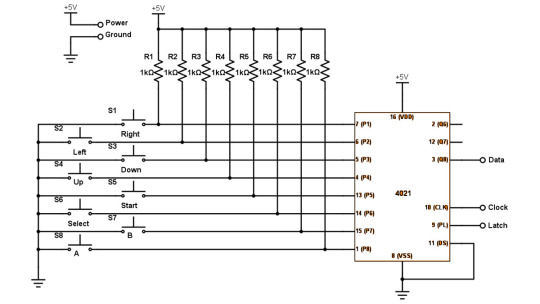
In the core of the gamepad is a single CD4021 chip. It is an 8-stage parallel input/serial output shift register. Here is a diagram of its internal logic: the chip has eight inputs for parallel input and outputs from the last three flip-flops.
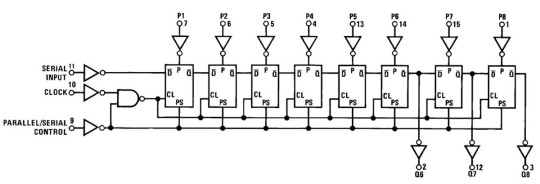
This should look familiar to our audience: a sequence of synchronous D flip-flops passing the torch of data bits from one to another. Oh, that's our combination lock from the post on flip-flops!

The CD4021 chip has two operating modes: serial and parallel. In parallel mode, eight flip-flops store information from eight inputs, each individually, regardless of clock pulses.
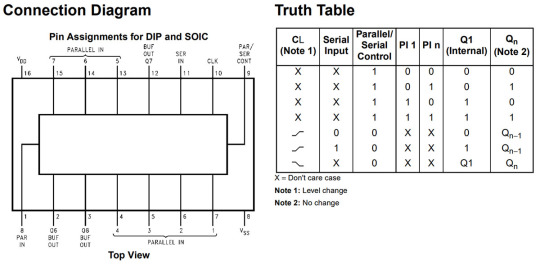
In serial mode, at the edge of the clock pulse, each subsequent flip-flop receives a data bit from the previous one, and the first flip-flop gets an incoming one from the serial input.
Then, where is the input pin to reset all flip-flops? The answer is there's none. However, you can pull the serial input low and send eight consecutive clock pulses. If necessary, we can write zeros to all memory cells. Although, in the case of a gamepad, one can do without it.
Simply switch the chip to parallel input mode, and it will save the state of the buttons. Pressed-down buttons correspond to logical zeros; released buttons correspond to logical ones because parallel inputs of the CD4021 in the NES gamepad are pulled by resistors to the power supply positive.

In this case, the DATA wire connected to the output of the eighth flip-flop will contain the state of the button S8 ('A'). We switch the chip to serial mode, apply clock pulses, and read S7 ('B'), then S6 ('Select'), all the way to S1 ('Right').
Congratulations! We have read the state of eight buttons via three signal wires (plus two power wires). Then we toggle to parallel mode again, rinse and repeat. This mode toggling is performed lightning fast, and the player will feel like the console responds to button presses instantly.
But what if it’s the other way around, and one doesn’t need to read information from buttons but to write it into cells, for example, by lighting LEDs? Then, a shift register with serial input and parallel output will help.
An example of such a shift register is CD40194. Unlike CD4021, it has not 8, but only 4 digits. Yet it's got parallel output and input, as well as serial input, with the ability to shift both to the right and left!
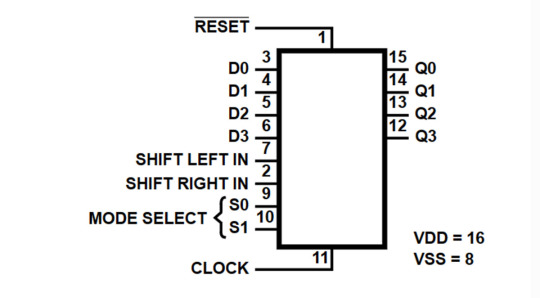
Does the CD40194 have a serial output, though? I hear you asking. Of course, it has! Q3 will be the serial output when shifted to the right, and Q0 will be the serial output when shifted to the left.
The CD40194 also has a general reset input. And there are also two mode selection inputs: S0 and S1.
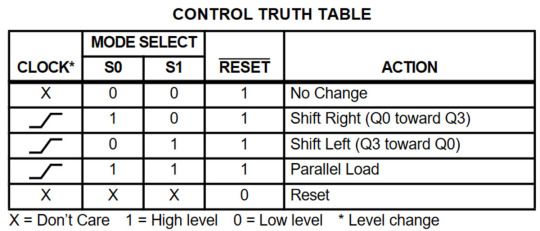
When S0 = 0 and S1 = 0, nothing happens. The chip does not respond to signals other than a general reset, retaining the saved 4 bits of information present at its outputs Q0..Q3.
When S0 = 1 and S1 = 0, a shift to the right occurs at the leading edge of the clock pulse, from Q0 towards Q3. And the value from the left-most serial input is written to Q0.
When S0 = 0 and S1 = 1, a shift to the left occurs at the leading edge of the clock pulse, from Q3 towards Q0. Q3 records the logic level from the right-most serial input.
When S0 = 1 and S1 = 1, logic levels from parallel inputs are read and passed to the output. Moreover, unlike the CD4021, this action requires the leading edge of the clock pulse!
A low level on the master reset input sets all outputs to zero, regardless of clock pulses and the selected operating mode. Let's assemble a simple experimental setup to get a complete picture of the CD40194 chip's operation.
According to the most common scheme, the clock generator is assembled on the U4 NE555 chip. Pulses from its output are sent to the input of CLK U3 CD40194.
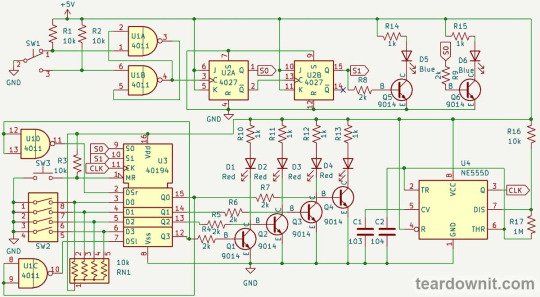
Using the SW2 block of 4 microswitches, you can send logical ones and zeros to the parallel inputs of the shift register. Resistors of the set RN1 pull the inputs high, and closed switches connect them to the ground, i.e., pull them low to obtain logical zero.
The reset button SW3 with the pull-up resistor R3 works the same way.
The U1 chip is a four-ship of double-input NAND gates. Both inputs of elements U1C and U1D are connected to each other. This way, the NAND element loses 'AND' and turns into the 'N' (NOT) element—a logical inverter.
Through the inverter U1C, the inverted signal from the left-most output of Q0 goes to the left-shift input, and through U1D, the inverted logic level from the right-most output of Q3 goes to the right-shift input.
Thus, when switching the mode to shift-right, the inverted value of Q3 will be written to Q0; the previous value of Q0 moves to Q1, previous Q1 to Q2, and previous Q2 to Q3.
If the initial state before switching to right shift was all zeros, or if you keep pressing reset in right-shift mode, the register will gradually fill with ones.
When the flow of ones reaches the end (Q3), the value one will be inverted, and the register will start filling itself with zeros. And when a zero reaches Q3, the cycle will repeat.
The same process will only happen in the opposite direction when switching to the shift left mode.
And in parallel input mode, the register will read the position of the microswitches whenever a clock pulse arrives.
To visually indicate the operating modes of the CD40194 shift register, we've assembled a two-digit pulse counter on two flip-flops of the U2 CD4027. They operate as a frequency divider and cycle between four states: 00 → 01 → 10 → 11.
The state of the CD40194's outputs is indicated by four red LEDs. The status of its control inputs is indicated by two blue LEDs (one of which had to be replaced with a green one because the blue one was faulty). The LEDs are turned on using S9014 transistors.
Pulses for a two-bit binary counter that switches shift register modes are generated by an RS flip-flop on two NAND gates, U1A and U2A. It switches when the button SW1 is pressed. We've talked about the operation of such a circuit in the post about flip-flops.
The video shows this experimental circuit board in operation.
youtube
0 notes
Quote
Before we go more deeply into the layout of the cortical homunculus, perhaps it’s worth saying that there are actually multiple body maps in the brain. What you see in diagram 1 are the two primary ones—the first that were discovered, and consequently the most well-known: the motor cortex, which governs the activation of the muscles (movement), and the somatosensory cortex, which receives continuous sensory information from the whole body. In fact, it turns out that there may be four separate parallel body maps in the somatosensory cortex alone, with one dedicated to light touch, one primarily responding to proprioceptive signals (where your limbs are in space relative to each other and to the body, derived from muscle activation information), and the others receiving a mix of inputs—it gets complicated pretty quickly. There are also two separate body maps in the cerebellum, active in maintaining balance, as well as learning and remembering sequenced movements. Deeper within the brain, from the brainstem, to the thalamus, and up to the insular cortex, there are multiple internal body maps relating primarily to feelings, emotions, and motivation, but also to balance and the maintenance of homeostasis. In fact, it may be misleading to think of all these body maps as distinct, separate things (though that does seem to be the dominant tendency); rather, as we learn more about these various body maps, a densely interlinked and interdependent picture is emerging wherein our body maps may not really be separate from each other at all. Since these maps are all interlinked with the body itself, they don’t exist as something separate in the way that a map appears to be separate from the territory it depicts. Our brain maps are actually part of our body. So when you relax your body, or scan your body, are you scanning your body, or are you scanning your brain? Is there actually any difference?
Neuroscience-Infused Body Scan – The Mindfulness Bell
0 notes
Text
Links between writting stlye and long term storage location: why anecdotes are effective
(conciseness doesn't need to be the name of the game)
Works of Narrative and Expository writting may not differ heaily in the information they convey, but the distinction in the styles of writing may actually correspond to differential storage of information encoded in Narrative and Expository structures.
Narrative writting is rich with imagery, the goal is emmersion, the aim is to forge a perceptual experience in the absence of actual sensory inputs. This activates the same encoding, consolidation, and storage systems as real life perceptual experience- activating precepts stored in perceptual aread, the visuospatial sketchpad, and ultimately, storage of narrative information in episodic memory.
The aim of expository writting on the other hand, is to deposit information into working memory (typically the phonological loop, as most expository writting is, well, verbal..) as efficiently as possible for immediate semantic processing and commitment into sematic LTM storage.
This is the start of an essay whose thesis will ultimately be that a narrative approach to conveying challenging factual concepts and information may be far more successful than a straight to the point expository style, because processing and interpretting perceptual information in context, and with reference to its impact on our own experiences ismore in line with the evolutionary origins of cognitive systems (as complex control systems guiding self preservation, and *not* storage spaces for accurate, yet irrelevant external information.)
establish the sequence of transmission of information drawing on multiple store model and also shannon's information transmission model
draw out two parallel diagrams of how perceived information gets filed into either episodic or semantic storage
discuss consolidation and transfer from episodic processing ares (hippocampus) to semantic storage areas (neocortex), and the resulting persistence of consolidated memory
superior persistence of autobiogrphical memory (which, by its nature starts out in episodic form), in both epiodic and semanic stores
All of this is normal, but what is happening when we try to encode semantic information directly without a corresponding episodic context?
Interdependence of episodic and semantic memory: Evidence from neuropsychology
Perceptual and semantic contributions to episodic memory: evidence from semantic dementia and Alzheimer's disease
Memory Systems Do Not Divide on Consciousness: Reinterpreting Memory in Terms of Activation and Binding
~ style note- how cool would it be to actually write this essay in narrative form
0 notes
Text
Sequence diagram parallel

SEQUENCE DIAGRAM PARALLEL HOW TO
SEQUENCE DIAGRAM PARALLEL SOFTWARE
P.S: this example shows 2 threads, but you can add more threads by adding more horizontal dashed lines. A sequence diagram is the most commonly used interaction diagram. UML guides the creation of multiple types of diagrams such as interaction, structure and behaviour diagrams.
SEQUENCE DIAGRAM PARALLEL SOFTWARE
Graphically (see link), the combined fragment is represented as a boxed region in your sequence diagram, parallel sequences being separated by horizontal dashed lines (each of the slices would then correspond to one thread of execution. Unified Modelling Language (UML) is a modeling language in the field of software engineering which aims to set standard ways to visualize the design of a system. The parallel combination fragment is drawn using a frame, and you place the text par in.
SEQUENCE DIAGRAM PARALLEL HOW TO
So how to show that interactions may happen in parallel ?įor representing parallelism, you would use a combined fragment introduced by the operator par. Changes to the sequence diagrams notation set in UML 2 have. In principle, the sequence of the interactions with your object is indicated by the vertical order of the messages. Select first an element where a new Sequence Diagram to be contained as a child. On the lifeline, which is indicated as a dashed vertical line, events occur in the form of rectangles, called activation boxes (or bars). Our development team is working on larger improvements to the functionality of our UML markup tool, and we would love to hear your feedback on this. A lifeline may begin with a labeled rectangle shape (an object) or an actor symbol. As a workaround, I recommend manually adding a dotted line to separate parallel events once you have built your diagram using the markup tool. It could be thread instantiations directly, or it could be several objects that are created in the context of the two threads.īut this is not sufficient. A sequence diagram shows parallel (dashed) vertical lines, called lifelines. Object There are three ways of naming objects: Includes the object name and class name, for example: live class: class, in the time series diagram, with object. You would also represent with a lifeline each threaded object that interact with your shared object. Actor System actors, which can be people, machines, other systems, subsystems used to represent in the temporal sequence diagram. So your object that is shared between the threads should appear once and only once in the diagram. state chart diagram, sequence diagram, collaboration diagram, activity diagram, component. can be used to explore/discover parallel activities. In a sequence diagram, a lifeline represents an individual participant in the interaction. parallel applications through of a group of diagrams 5. Use case diagrams are the primary tool to document requirements Use cases provide the basis of.

0 notes
Text
semi-permanent hiatus? idk i might return some day... neri is the name, extragalactic astronomy is my game
i'm an astrophysics phd candidate researching galaxy formation and evolution, focusing (for now) on a transitioning galaxy population known as the green valley. i'm happy to answer any and all questions about physics and astronomy to the best of my abilities. i'll be exhilarated if you ask me about my research
i love reading and wish i had more time for anything other than science papers (ask me for my goodreads)
i'm very into manga right now. some of my favorites are skip and loafer, mob psycho 100, dungeon meshi, witch hat atelier and hunter x hunter. i'm currently reading hirayasumi and mushishi
revolutionary girl utena is one of my favorite works of art of all times
my taste in music is all over the place, but i've been in a classical music kick for over a year now. please fight me over which interpretations of beethoven's piano sonatas are the best
my url is a reference to boltzmann's entropy formula: S = k.log(W)
my blog title is the name of a book by sadie carnot on heat engines
my icon is from skip and loafer
my header is the JWST deep field
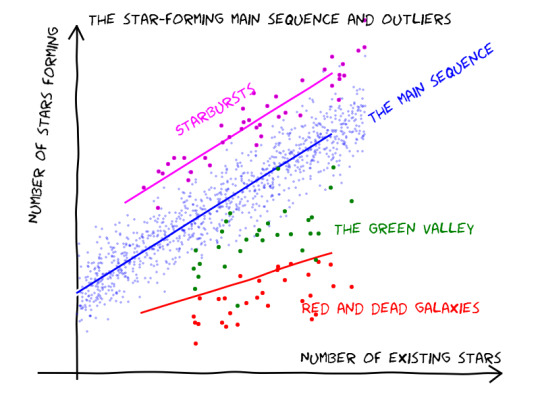
[image id]: a diagram titled the star-forming main sequence and outliers. the x-axis is labeled number of existing stars and the y-axis is labeled number of stars forming. on the upper left-hand corner, a pink line segment labeled starbursts is accompanied by corresponding pink data dots. bellow it, a parallel blue line segment labeled the main sequence is surrounded by a much larger number of smaller dots. futher down, a somewhat flatter red line segment and its accompanying dots are labeled red and dead galaxies. between the main sequence and the red and dead lines are a few scattered green dots labeled the green valley. [end id]
26 notes
·
View notes
Text
As the final peepaw poll comes to a close, I’m gonna share some of my favorite panels from my Ghost In The Shell animatic.


I love the sequence where time passes a lot (and Ghost’s hoard of coffee mugs grows) but this bit where he gives up on the dimentional travel machine I am especially find of. I’m really pleased with the implied story of the ripped schemetics in particular.


I am also genuienly in love with the parallel shots and I really like this drawing of the 03 turtle tots. I got better and better at drawing the 03 turtles as I went along, so I think Mikey came out the best even though his pose was kinda difficult.


Look, these are just really nice still shots. I’m really proud of how Mikey and Donnie came out here.


Again, I love all the parallel shots, expect to be seeing more of them. Also, another 03 turtle tot drawing.


I am very fond of these drawings of Ghost teaching Leo medicine and denying Donnie uranium. Scenes in Donnie’s lab always have some of the most detailed backgrounds, and I just really like the diagrams I wrote for both these panels with Leo’s veternarian textbook and Donnie’s presentation, lmao.






I just love the parallel panels! I’m SUPER proud of Leo, I was able to locate an image of the teapot they had in 03 and I was, like, vibrating with excitement to make this comparison, especially since GitS points out specifically Leon’s tea brewing as something that reminds Ghost of Leonardo. (Also, I was very greatful the two teapots had similar handels so I could keep the pose as similar as possible)
I was also getting better at drawing Rise!Raph at this point, and I am really proud of how he came out! His pose was pretty difficult, but I’m very happy with it.
And Mikey, lol. Always the cook, not always good at it.
Those are all the panels I’m really, really proud of and we’re going to ignore the panels where I made a mistake. Feel free to ask me if any of you want me to post a specific panel for some reason. Everyone enjoy the final round of the peepaw poll, it’s been a great time, and be sure to check out all the amazing AUs everyone’s made and shower their creaters with well-deserved praise.
46 notes
·
View notes
Note
Forgive me Father, I have no awful headcanons for you, only a general question on comic making. How do you do it, writing-wise/how do you decide what points go where, how do you plot it out (or do you have any resources on the writing aspect that you find useful?) Not to get too bogged down in details, but I attended a writer’s workshop and the author in residence suggested I transfer my wordy sci-fi WIP into graphic novel script, as it might work better. (I do draw, but I don’t know if I have it in me to draw a whole comic—characters in motion? Doing things? With backgrounds? How dare, why can’t everyone just stand around looking pretty)
I was interested but it quickly turned into a lot of internal screaming as I tried to figure out how to compress the hell out of it, since novels are free to do a lot more internal monologuing and such compared to a comic format (to say nothing of trying to write a script without seeing how the panels lay out—just for my own sake, I might have to do both concurrently.)
As an aside, to get a feel for graphic novels I was rereading 99RM and was reminded of how great it was—tightly plotted, intriguing, and anything to do with Ashmedai was just beautifully drawn. I need more Monsignor Tiefer and something something there are parallels between Jehan and Daniel in my head and I don’t know if they make sense but it works for me. (As an aside, I liked the emphasis on atonement being more than just the word sorry, but acknowledgment you did wrong and an attempt to remedy it—I don’t know why that spoke to me the way that it did.)
I thought Tumblr had a word count limit for asks but so far it has offered zero resistance, oh well. I don’t have much else to say but on the topic of 99RM, Adam getting under Monsignor’s skin is amazing, 10/10 (about the Pride picture earlier)
wow tumblr got rid of the markdown editor! or at least in asks which means the new editor probably has no markdown....god i hate this site! anyway...
Totally! So first, giant thank you for the compliments! Second, I have a few questions in turn for you before I dive into a sort of answer, since I can give some advice to your questions in general but it also sounds like you have a specific conundrum on your hands.
My questions to your specific situation are:
did the author give any reason for recommending a, in your words, "wordy" story be turned into a graphic novel?
is the story you're writing more, like you said, "internal monologuing"? action packed? where do the visuals come from?
do you WANT it to be a comic? furthermore, do you want it to be a comic you then must turn around and draw? or would you be interested in writing for comics as a comic writer to have your words turned into art?
With those questions in mind, let me jump into the questions you posed me!
Let me start with a confession...
I've said this before but let me say it again: Ninety-Nine Righteous Men was not originally a comic — it was a feature-length screenplay! And furthermore, it was written for a class so it got workshopped again and again to tighten the plot by a classroom of other nerds — so as kind as your compliments are, I'm giving credit where credit is due as that was not just a solo ship sailing on the sea. On top of that, it got adapted (by me) into a comic for my thesis, so my advisor also helped me make it translate or "read" well given I was director, actor, set designer, writer, editor, SFX guy, etc. all in one. And it was a huge help to have someone say "there is no way you can go blow by blow from script to comic: you need to make edits!" For instance, two scenes got compressed to simple dialogue overlaid on the splashpage of Ashmedai raping Caleb (with an insert panel of Adam and Daniel talking the next day.) What had been probably at least 5 pages became 1.
Additionally, I don't consider myself a strong plotter. That said, I found learning to write for film made the plotting process finally make some damn sense since the old plot diagram we all got taught in grammar school English never made sense as a reader and definitely made 0 sense as a writer — for me, for some reason, the breakdown of 25-50-25 (approx. 25 pages for act 1, 50 for act 2 split into 2 parts of 25 each, 25 pages for act 3) and the breaking down of the beats (the act turning points, the mid points, the low point) helped give me a structure that just "draw a mountain, rising action, climax is there, figure it out" never did. Maybe the plot diagram is visually too linear when stories have ebb and flow? I don't know. But it never clicked until screenwriting. So that's where I am coming from. YMMV.
I should also state that there's Official Ways To Write Comic Scripts to Be Drawn By An Artist (Especially If You Work For A Real Publisher As a Writer) and there's What Works For You/Your Team. I don't give a rat's ass about the former (and as an artist, I kind of hate panel by panel breakdowns like you see there) so I'm pretty much entirely writing on the latter here. I don't give a good god damn about official ways of doing anything: what works for you to get it done is what matters.
What Goes Where?
Like I said, 99RM was a screenplay so it follows, beat-wise, the 3-act screenplay structure (hell, it's probably more accurate to say it follows the act 1/act 2A/act 2B/act 3 structure.) So there was the story idea or concept that then got applied to those story beats associated with the structure, and from there came the Scene-by-scene Breakdown (or Expanded Scene Breakdown) which basically is an outline of beats broken down into individual scenes in short prose form so you get an overview of what happens, can see pacing, etc. In the resources at the end I put some links that give information on the whole story beat thing.
(As an aside: for all my short comics, I don't bother with all that, frankly. I usually have an image or a concept or a bit of writing — usually dialogue or monologue, sometimes a concrete scene — that I pick at and pick at in a little sketchbook, going back and forth between writing and thumbnail sketches of the page. Or I just go by the seat of my pants and bullshit my way through. Either or. Those in many ways are a bit more like poems, in my mind: they are images, they are snapshots, they are feelings that I'm capturing in a few panels. Think doing mental math rather than writing out geometric proofs, yanno?)
Personally, I tend to lean on dialogue as it comes easier for me (it's probably why I'm so drawn to screenwriting!) so for me, if I were to do another longform GN, I'd probably take my general "uhhhhhh I have an idea and some beats maybe so I guess this should happen this way?" outline and start breaking it down scene by scene (I tend to write down scenes or scene sketches in that "uhhhh?" outline anyway LOL) and then figure out basic dialogue and action beats — in short, I'd kind of do the work of writing a screenplay without necessarily going full screenplay format (though I did find the format gave me an idea of timing/pacing, as 1 page of formatted script is about equal to 1 minute of screentime, and gave me room to sketch thumbnails or make edits on the large margins!) If you're not a monologue/soliloque/dialogue/speech person and more an image and description person, you may lean more into visuals and scenes that cut to each other.
Either way this of course introduces the elephant in the panel: art! How do you choose what to draw?
The answer is, well, it depends! The freedom of comics is if you can imagine it, you can make it happen. You have the freedoms (and audio limitations) of a truly silent film with none of the physical limitations. Your words can move in real time with the images or they can be a narrative related to the scene or they could be nonsequitors entirely! The better question is how do you think? Do you need all the words and action written first before you break down the visuals? Do you need a panel by panel breakdown to be happy, or can you freewheel and translate from word and general outlines to thumbnails? What suits you? I really cannot answer this because I think when it comes to what goes where with regard to art, it's a bit of "how do you process visuals" and also a bit of "who's drawing this?" — effectively, who is the interpreter for the exact thing you are writing? Is it you or someone else? If it's you, would you benefit from a barebones script alongside thumbnailed paneling? Would you be served by a barebones script, then thumbnails, then a new script that includes panel and page breakdowns? What frees you up to do what you need to do to tell your story?
If I'm being honest, I don't necessarily worry about panels or what something will look like necessarily until I'm done writing. I may have an image that I clearly state needs to happen. I may even have a sequence of panels that I want to see and I do indeed sketch that out and make note of it in my script. But exactly how things will be laid out, paneled, situated? That could change up until I've sketched my final pencils in CSP (but I am writer and artist so admittedly I get that luxury.)
How do I compress from novel to comic?
Honest answer? You don't. Not really. You adapt from one to another. It's more a translation. Something that would take forever to write may take 1 page in a comic or may take a whole issue.
I'm going to pick on Victor Hugo. Victor Hugo spent a whole-ass book in Notre-Dame de Paris talking about a bird's eye view of Paris and other medieval architecture boring stuff, with I guess some foreshadowing with Montfaucon. Who cares. Not me. I like story. Anyway. When we translate that book to a movie any of the billion times someone's done that, we don't spend a billion years talking at length about medieval Paris. There's no great monologuing about the gibbet or whatever: you get to have some establishing shots, maybe a musical number, and then you move tf on. Because it's a movie, right? Your visuals are right there. We can see medieval Paris. We can see the cathedral. We can see the gibbet. We don't need a whole book: it's visually right there. Same with a comic: you may need many paragraphs to describe, say, a space station off of Sirius and one panel to show it.
On the flip side, you may take one line, maybe two, to say a character keyed in the special code to activate the holodeck; depending on the visual pacing, that could be a whole page of panels (are we trying to stretch time? slow it down? what are we emphasizing?) A character gives a sigh of relief — one line of text, yeah? That could be a frozen panel while a conversation continues on or that could be two (or more!) panels, similar to the direction [a beat] in screenwriting.
Sorry there's not a super easy answer there to the question of compression: it's a lot more of a tug, a push-pull, that depends on what you're conveying.
So Do I Have It In Me to Write & Draw a GN?
The only way you'll know is by doing. Scary, right? The thing is, you don't necessarily need to be an animation king or God's gift to background artists to draw a comic.
Hell, I hate backgrounds. I still remember sitting across from my friend who said "Claude you really need to draw an establishing exterior of the church at some point" and me being like "why do you hate me specifically" because drawing architecture? Again? I already drew the interior of the church altar ONCE, that should be enough, right? But I did draw an exterior of the church. Sorta. More like the top steeple. Enough to suggest what I needed to suggest to give the audience a better sense of place without me absolutely losing my gourd trying to render something out of my wheelhouse at the time.
And that's kinda the ticket, I think. Not everyone's a master draftsman. Not everyone has all the skills in every area. And regardless, from page one to page one hundred, your skills will improve. That's all part of it — and in the meantime, you should lean into your strengths and cheat where you can.
Do you need to lovingly render a background every single panel? Christ no! Does every little detail need to be drawn out? Sure if you want your hand to fall off. Cheat! Use Sketchup to build models! Use Blender to sculpt forms to paint over! Use CSP Assets for prebuilt models and brushes if you use CSP! Take photographs and manip them! Cheat! Do what you need to do to convey what you need to convey!
For instance, a tip/axiom/"rule" I've seen is one establishing shot per scene minimum and a corollary to that has been include a background once per page minimum as grounding (no we cannot all have eternal floating heads and characters in the void. Unless your comic is set in the void. In which case, you do you.) People ain't out here drawing hyper detailed backgrounds per each tiny panel. The people who DO do that are insane. Or stupid. Or both. Or have no deadline? Either way, someone's gonna have a repetitive stress injury... Save yourself the pain and the headache. Take shortcuts. Save your punches for the big K.O. moments.
Start small. Make an 8-page zine. Tell a beginning, a middle, an end in comic form. Bring a scene to life in a few pages. See what you're comfortable drawing and where you struggle. See where you can lean heavily into your comfort zones. Learn how to lean out of your comfort zone. Learn when it's worth it to do the latter.
Or start large. Technically my first finished comic (that wasn't "a dumb pencil thing I drew in elementary school" or "that 13 volume manga I outlined and only penciled, what, 7 pages of in sixth grade" or "random one page things I draw about my characters on throw up on the interwebz") was 99RM so what do I know. I'm just some guy on the internet.
(That's not self-deprecating, I literally am some guy on the internet talking about my path. A lot of this is gonna come down to you and what vibes with you.)
Resources on writing
Some of these are things that help me and some are things that I crowd-sourced from others. Some of these are going to be screenwriting based, some will be comic based.
Making Comics by Scott McCloud: I think everyone recommends this but I think it is a useful book if you're like "ahh!!! christ!! where do I start!!!???" It very much breaks down the elements of comics and the world they exist in and the principles involved, with the caveat that there are no rules! In fact, I need to re-read it.
Comic Book Design: I picked this up at B&N on a whim and in terms of just getting a bird's eye view of varied ways to tackle layout and paneling? It's such a great resource and reference! I personally recommend it as a way to really get a feel for what can be done.
the screenwriter's bible: this is a book that was used in my class. we also used another book that's escaping me but to be honest, I never read anything in school and that's why I'm so stupid. anyway, I'd say check it out if you want, especially if you start googling screenwriting stuff and it's like 20 billion pieces of advice that make 0 sense -- get the core advice from one place and then go from there.
Drawing Words & Writing Pictures: many people I know recommended this. I think I have it? It may be in storage. So frankly, I'd already read a bunch of books on comics before grabbing this that it kind of felt like a rehash. Which isn't shade on the authors — I personally was just a sort of "girl, I don't need comics 101!!!"
Invisible Ink: A Practical Guide to Building Stories that Resonate: this has been recommended so many times to me. I cannot personally speak on it but I can say I do trust those who rec'd it to me so I am passing it along
the story circle: this is pretty much the hero's journey. a useful way to think of journeys! a homie pretty much swears by it
a primer on beats: quick google search got me this that outlines storybeats
save the cat!: what the above refers to, this gives a more genre-specific breakdown. also wants to sell you on the software but you don't need that.
I hope this helps and please feel free to touch base with more info about your specific situation and hopefully I'll have more applicable answers.
82 notes
·
View notes
Note
What advice can you give for making a dialogue sequence flow better. Rather than just saying he said, she said, etc.? Please and thank you (●'◡'●)
Hi! That’s a great question, anon!
I know it was definitely something I struggled with when I was a newer writer because so often I think when we’re first approaching writing, we tend to put a lot of weight in dialogue. That’s not a bad thing necessarily, dialogue is an important part of storytelling, more so for some writers than others. Amy Sherman-Palladino who created Gilmore Girls and The Marvelous Mrs. Maisel is a very dialogue-driven writer for instance, whereas Vince Gilligan who created Breaking Bad and Better Call Saul often prioritises silence and lets visual language stand alone, but the way they use the dialogue they have, whether it be with a light touch or a heavy hand, isn’t really about the dialogue at all, it’s about tone and rhythm.
As you grow as a writer, I think you start to get more of a sense of what that means, but an example and an exercise I use a lot when I’m teaching creative writing is to take the scenario of two girls walking through a forest. Try writing it as a horror, and then try writing it as a light drama. The scenario itself can be either, it’s the tone that creates the story, and as a part of that, what changes is setting and environment, dialogue, and actions.
In one, you’ll have twisting branches and darkness and panicked breaths and scrambling hands, and in the other you’ll have lush trees and warm midday light and laughter and gentle touches.
You’ll also have very different dialogue, and therefore very different context for which that dialogue is delivered. What helps it flow, as you put it, is something that’s responsive to the story that you’re telling and what else is happening in the scene.
So! Let’s break that down a little!
When you're thinking about anything on a scene level, I think it really boils down to six questions:
What's the story you're telling?
What's the purpose of your scene?
Where are your characters? What is the environment they're in?
What are they doing as they talk?
What is the context of the characters' relationship?
How are the characters feeling?
That's kind of a lot, haha, so I'll try to keep this relatively short.
What’s the story you’re telling?
This really comes back to what I was saying above about the story you’re telling having an impact on how you use all narrative devices whether that be dialogue, description or setting. It would make no sense for Walt in Breaking Bad to talk like Lorelai from Gilmore Girls or vice versa for instance – that’s not the story that the writers are trying to tell. Walt’s limited dialogue helps to reflect his secretive nature and the dark mood of the story overall, while Lorelai’s rapid-fire dialogue and tendency to be doing a lot while she talks reflects the frenetic energy of the show and the gravitational pull she has on those around Star’s Hollow.
The dialogue – and the way that dialogue is delivered – helps to embed the viewer or reader and create a tone that matches the story you want to tell.
What’s the purpose of your scene?
More than that, how you use dialogue and the cues around dialogue helps to realise the purpose of your scene.
All scenes have a purpose.
Scenes are the building blocks of your story. They are what get you from the floor to the ceiling, and you need to know what each of those building blocks is doing.
That doesn't have to be a lot! Sometimes a building block is just 'character has a bird poop on them on their way to the party'. On its own, the scene might seem light, but the purpose is actually to set up that they're about to have a really bad time at the party. That's great! Because you know the purpose of that scene therefore is Foreshadowing.
The point is though that that purpose - whether big or small - will impact the way your characters behave and interact not only with other characters, but the environment around them.
If the purpose is, for instance, two characters misunderstanding each other, they’ll likely be frustrated or hurt, which will contribute to not just what they say, but their tone of voice and their posture, and the space. They might feel the chill of the air conditioning a little more acutely, grab a couch cushion to hug to their chest, distract themselves by putting dishes away with stiff hands, push a hip into the kitchen counter hard enough to leave a mark.
Purpose informs tone which informs character which informs action.
Which brings me to a big point.
Where are your characters? What is the environment that they’re having this conversation in?
This is something I see often neglected in writing from newer writers. Which is a shame! Space can bring so much to your story – not only in terms of grounding your readers, but providing entry points and understanding to your characters state of mind without you having to explicitly say it. How your characters feel that environment, what they focus on, is a way to explore how they’re feeling and can punctuate your dialogue (but I’ll come back to that point in a minute).
For instance, things like weather and temperature, wide open spaces vs tiny, cluttered rooms, other characters in those environments (I always encourage people to draw diagrams of rooms and map out character action. It might sound a little silly, but trust me, it helps a LOT), and the characteristics of those spaces (like I said above with barren, twisting branches vs lush trees as a very broad example) are all things that are going to contribute to the way you build a scene.
And more than that, what your character’s doing as they talk.
Which, hey! What are they doing as they talk?
It’s pretty rare for people to do nothing as they have a conversation – they doodle on sketchbooks, or roll their eyes, take sips of their drink, flail and gesture, reach out to touch the other person's hand, pet their dog, check their phones, get dressed or undressed – and that’s not even including the bigger acts that might be in your story – running from an enemy, cooking a feast for a huge party, getting into a fistfight, hacking into a secret government database, etc etc.
This is often a question I fall back on, and try to imbue in my writing. Take this little bit from Clean Like Him, where Beth is having a tense conversation with Rio in Paper Porcupine.
“Official launches make businesses feel real,” she says tersely instead, irritation seeping into her tone as she slashes the last row of paper. She collects the cuttings, organises the notes and checks the edges, mostly just to have something to do with her hands. So they won’t hang awkward at her sides or balled into fists or – worse – touch him somehow (god, why is she thinking about touching him? Stupid. She clears her throat. Refocuses.) “And if this is going to work, we need it to feel real, remember?”
Beth's working, but I explicitly say she wants to have something to do with her hands to distract herself from him, and her actions are jerky, her task a little aggressive, which is really about showing that she's on edge and punctuating a tenser tone.
The point is, all of these things are actions that are going to interrupt and interact with your dialogue and what that feels like depends on history and feelings.
Who's having the conversation, and what's the history of their relationship?
This might sound like an obvious one, but I think sometimes people can underestimate the impact that it actually has on an exchange. How familiar your characters are with one another and what the context of their relationship is has huge impacts on how a scene plays out and what a character might be doing.
Beth and Rio for instance knowing each other so well and not knowing each other at all is actually a pretty complicated dynamic to capture, especially when it's often paralleled with Beth and Dean who also know each other so well and not at all but in a completely different way, haha. These contexts though are going to affect how they interact. After all, Beth's not going to treat Rio the same way she treats Dean because that history and that context is different.
Really thinking about what that means is going to help you to think about the way these characters interact both broadly and specifically to what you're writing, which in turn is going to help you start to find a rhythm to their conversation.
How are your character’s feeling?
This is really the lynchpin of all of the above. How your character is feeling is going to define the purpose of your scene, how they interact with their environment and other characters, and what it is they’re doing. A character who’s frazzled is going to have more scattered dialogue, a more urgent tone, they’re going to pick up the wrong thing or lose things and their relationship with their space will be different.
Think of Beth in 2.07 when Jane’s missing. She and Dean go to a private space – his home office – to have a fight even though their house is full of police, neighbours and friends, and Beth is furious at him, and he throws something historic at her (and important to the context of their current relationship) - Rio shooting him - to deflect from his failure as a parent.
Immediately afterwards, Beth is frazzled and desperate. Her tone becomes harried, she can’t find her car keys and rummages through her handbag and the things on the hall table, even though she’s holding them, something Ruby has to point out, and then she leaves to find Rio to try and get him to help her.
The dialogue itself is there to build tone and atmosphere and in fact, Beth’s dialogue with Dean is punctuated by her tone and anger, not her words – she doesn’t tell Dean she doesn’t think Rio would ever take the children, she throws the question back at him and her fury is what tells us as an audience what she thinks.
Tone is what generates atmosphere and meaning, and to work out what your tone is is to understand the purpose of your scene and your character’s feelings, which in turn determines how they respond to their environment and tasks, and it’s that response that punctuates feelings and tone.
It’s all a bit of a snake eat tail situation, haha, but my point is, thinking about dialogue tags and flow is really thinking about the energy and context of an interaction, and the tone and the purpose of a scene. Think about sensory description, think about space, think about what a character might be doing as they navigate that interaction, and think about how you can use that to further explore the character’s interior life.
But most importantly, always be thinking about what you want your readers to take away from the interaction.
I’ve plucked another scene out of my most recent fic, Clean Like Him, just because it’s still pretty fresh in my head, and I've marked a few of these points in these screenshots (please open the image in a new tab so you can, y'know, actually read it, haha)
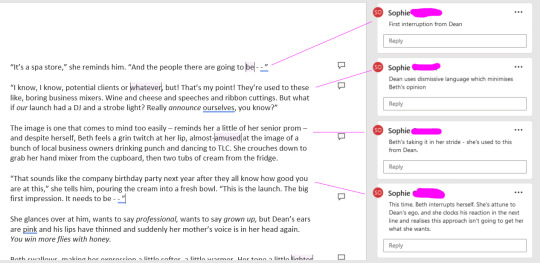
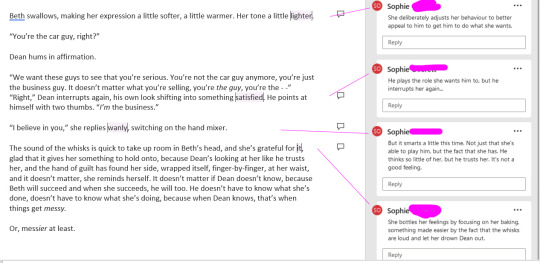
A lot of this excerpt is reliant on the context of Beth and Dean's relationship and the reality that Beth is using him but also still feels tied to him through their history, which in turn makes her feel guilty.
This is the second scene in the fic, so there's a lot of establishing stuff that comes up again later too – particularly Dean's insecurity and ego failings, and the fact that he diminishes and doesn't see her. Things like interruptions, like mid-conversation pivots, like wounded puppy expressions and Beth deliberately tuning him out are all utilised as active dialogue tags, but also tone and mood builders which hopefully creates the rhythm of the story.
You don't necessarily have to think about all this at once either. A lot of this sort of stuff I tend to work out more when I'm re-writing - so I'll already have a barer bones draft which is more about me putting the scene purpose down on paper; because, like I said, that's really the most important thing.
So yes! Sorry! That got a bit long, haha. I hope it's a help though, anon! Let me know if you have any questions 😊
#as always this is just advice#just stuff i've learned over the many many years at this point haha#hopefully though it's helpful to you anon!#and anyone else who's interested!#writing#writing advice#welcome to my ama
32 notes
·
View notes
Text
Does the idea of time presuppose dualism? Can time exist in a non-dual reality?
In my view, time is a spectrum of causality. In the center of the spectrum, time or causality is experienced with strong dualism. We typically experience an interior, subjective context of time that is somewhat elastic, relative to our experience of an exterior, objective context of time. We feel that clock time can speed by or crawl depending on our state of consciousness. I have attempted to depict this in the diagram as the Classical Time vs Personal Time or Metric vs Phoric duality.

Beneath this Personal scope of time and causality, I think there is a different paradigm, not only in scale (sub-personal = sensory-motive dynamics that weave the underlying fabric of personal scale perceptions as color pixels on a screen form the underlying fabric of an image) but of quality. The sub-personal sense of time and causality is what bubbles up into our conscious attention from below - as influential instincts, reflexes, and otherwise thoughtless urges that will tend to control behavior unless overridden from another level.
In this sub-personal or semaphoric context, causality is a divergence from a stream of generic, recursive, and reversible sequences. It is a wave-function collapse, in QM interpretation, but caused by the exercise of will at the sub-personal level. Our personal will dictates changes in sub-personal power to change the chemistry of our nervous system, and sub-personal sensitivities also dictate changes in our personal perception and will.
While the diagram appears to be dualistic all the way down, with two columns and three rows, what I propose is that the duality is maximized in the center/personal level and almost non-existent at the top and bottom. Sub-personal instincts and urges are isomorphic to quantum appearances, i.e. coincidence and intention are different only in a very subtle qualitative way. We can choose to look at it both ways and they are both supported (like an ambiguous duck-rabbit image), but we do still experience a sense of a direct power to choose. We can personally cause a sub-personal effect on our own perception that foregrounds the duck image and backgrounds or hides the rabbit image.
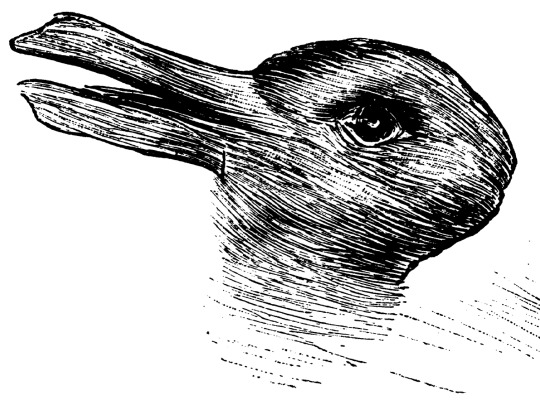
If we think instead of a Rorshach inkblot image, the emergence of imagery is much more plastic and conditioned by the content of not only our personal experiences but of transpersonal content. Psychologists like Jung theorized a collective unconscious - a pool of archetypes that include anthropomorphic ideas like ‘the hero’ as well as more cosmomorphic symbols such as mandalas.

What we happen to see in an inkblot, or in something like tea leaves, cards, or stars in the sky can give us access to a metaphoric level of awareness in which even seemingly random coincidences happen for a reason. In the multisenserealism diagram I’m mapping this synchronistic, holistic sense of time and causality as the isomorphic dual to cosmological models such as General Relativity and even Quantum Multiverse interpretations.
Again, even though there is a duality that arises from conceiving of the universe from the outside in, Western view versus the inside-out Eastern view, it is a parallel duality rather than the perpendicular duality of the Personal vs Classical level. The entire spectrum can be viewed as a ballooning of spatiotemporalization - a division of an eternal creative moment beyond time into dualism and then back into unity after being broken into infinitely brief, recursive moments where creativity is all-but-inaccessible.
In my view, human consciousness is a spectrum bounded by autism on one end and psychosis on the other, because it recapitulates a cosmological spectrum of consciousness which extends from unity to units. Autism is, for purposes of this comparison, an extreme cohesive rigidity while psychosis is an extreme adhesive receptivity. Both extremes are ultimately pathological because they impose subpersonal or transpersonal caliber sense-making within the personal domain of sense-making.
To answer the question, I think that time is actually a sense of causality and that causality is dependent on a modality of awareness. Duality is most pronounced and dimorphic in the personal modalities of awareness but nearly dissolves in the transpersonal and subpersonal modalities. Non-dual transpersonal time is an eternal creative moment while non-dual subpersonal time is a short routine of moments repeating eternally.
11 notes
·
View notes
Text
Tempting. But nah, I’m good. Unless? ;)
Summary: You find yourself attempting to swindle a witch. Naturally, it doesn’t work out and she casts a curse on you. How were you supposed to solve this curse before seven days?
Warnings: No smut but it’s basically an intro to a smut series; a prompt?
Word Count: 5,538
A/N: Oneshot? Series? We’ll find out in the next episode of-
Ao3 Link
This is her place, right? You’re sure this is the place you agreed to meet up on. You’ve double checked, no, triple checked your messages with the witch you met on bledit, Tituba. You’ve been to her house before but never in the dark. With your paranoia, you could only imagine how mortifying it would be if you were to arrive in a random demon or witch’s home, knocking on their door, and possibly being eaten or roasted alive. According to her message, you were at the correct destination... which was in the outskirts of the devildom, in the middle of the night.
At least, it felt like nighttime. Since the devildom had no sun - excluding Lord Diavolo’s private beach - your body had to adapt to the climate change and learned to tell time in a different way, and by that it meant you relied on your gut feeling and occasionally, checked the time on your DDD.
The gravel crunched and shuffled with each step you took, and with each step, your gnawing anxiety grew stronger. Please, there’s no way this is the wrong house. Although, maybe it was since it was pitch black and you were a powerless human in the night - ok - get a grip.
You know, maybe this wasn’t your brightest idea. I mean, what if you died in the most embarrassing way? What if a creature of Devildom decided to make you their food, feed you to their offspring, and leave your naked and mutilated body to be found. That’s just… no, you’d rather not think about that. You'd simply pass away if you let yourself die looking crusty as fuck.
Though, you wouldn't have found yourself in your little nighttime adventures if you'd just get a grip and master lucid dreaming the normal way. If you just had enough patience and practiced in a neat and timely routine, you would’ve mastered lucid dreaming and the ability to shift into your ‘desired reality’ as those clickclock creators instructed.
But who were you kidding? You know your dumb ass could never have the patience and consistency to do that. That’s like, some normie type of shit. And you? A whole ‘nother breed. Those foolish little clickclock creators have no idea that you were basically y/n and have a main character complex. What? Don’t look at me like that, me. We’re built? Different.
“Lucid dreaming isn’t that hard, it requires patience and understanding, yeah right,” you mocked the various clickclock creators and sent a pebble flying to a pile of rocks. “Stupid clickclock, stupid lucid dreaming, stupid hard and unobtainable 2d waifus and husbandos.”
All you wanted was to lucid dream once! Just once is enough. You wanted to open you eyes to an animated world and see your beloved 2D characters materialize right before you. Of course, you know it wasn’t all that possible to do in real life. I mean, if even the hardcore otaku himself hasn’t managed such a feat, how could you - the lowly human - accomplish what Mr. The Lord of Shadows couldn’t do for centuries?
And yeah, he’s the Lord of Shadows alright. If you learned anything from your writepod addiction in middle school, it’s the ability to spot a poorly disguised fan fiction based off of celebrities in real life from a mile away. Although, it did surprise you to find that the great author of the legendary TSL series was THE Simeon himself.
I mean, Simeon? Hello? The holiest of angels? That was a shocker.
OOF! You face planted into something soft, almost like a jello cup you’d eat in the summer. You were snapped out of your thoughts as you fell on the prickly leaves, ass first.
“Oh, what the fuck?” You balled your hands into fists and attempted to rub the disorientation away, and standing at a good 6’10” was quite possibly the tallest being you’ve ever laid your eyes on - and the most amusing to make fun of.
The witch fixed her gaze onto you, “you’re late.”
You felt a swirl of emotions wash over you. I wonder how you were going to torment her into casting a lucid dreaming spell on you. Or better yet, have her teach you how to shift realities with her witchy powers. Oh! Or even better, blackmail her into sending you off into a parallel universe in which your favorite anime are real and you were the all mighty ruler of that world, giving you the powers to switch dimensions and warp your realities with a snap of your fingers.
A grin tugged at your lips, “what’re yOu looking at Cocksucker69?”
The witch, Tituba, pressed her lips into a tight lipped smile and hissed, “I thought I told you to not refer to me as that, xXdiavoloismybitchXx.”
“I—“
“Did you forget what followed after you endeavored to bring me humiliation in public? Forget the way those demons turned around, their jaws slack with shock as I uttered your bledit username, exposing you as bledit’s most notorious troller, and all of your-“
“YES! I mean no! No, I haven’t forgotten. You right, my bad,” you shivered at the memory and shook your head.
It was as if it happened yesterday, because it did. It wasn’t the wide array of emotions the demons bore that bothered you. It was the fact Tituba emphasized your username, while you were in the entrance of RAD, no less!
You were one of the two only human exchange students and that made you quite a celebrity in the school. The demons knew that! They weren’t fools. Your username probably struck a cord that inspired a string of gossip and rumors to spread, that would no doubt reach Diavolo. You couldn’t bear the thought of reliving the wave - no, tsunami - of embarrassment that washed over you. No, it felt more like it drowned you. Like damn, that witch really had it out for you!
“Right so,” with a cheshire grin, you prod her arm with your elbow, “where were we?”
She groaned in exasperation.
“Child, you are accelerating my expiration,” the witch brought two fingers and pinched the space between her eyebrows, smoothing out her wrinkles, no doubt caused by you.
“I’ll behave this time, I swear! Scout’s honor!”
“Despite my knowing of my inevitable regret, I’m obligated to continue,” the witch pushed her door open and ushered you in. You stepped inside and a fresh crisp breeze licked at your cheeks. You sighed in content, welcoming the verdant ambiance of Tituba’s cottage.
The lace of your shoes became undone in a second, and in the next, you soared in the air and flopped unceremoniously on Tituba’s sex pit. It wasn’t an actual sex pit though. It was simply an indentation on the wooden floor that Tituba renovated into a conversation pit, which turned into her designated sleeping area, thanks to your persistence.
Pillows, throw pillows, plushies, fluffy blankets - if you had to choose a place to sleep for eternity, it would be Tituba’s sex pit. Your eyes widened in delight as it settled on the long shape of the body pillow you gifted Tituba as an apology gift… After you fell against her cauldron she was using to ferment blood moon water. It spilled all over the floor and became ‘unclean’ as she called it.
“Oh!!! The Barbatos body pillow I gifted you! I knew you still love me! You tsundere simp, you~!”
Tituba met your waggling eyebrows with an unamused stare. “Get to the point, MC.”
Just the slightest, you dipped your head, narrowed your eyes, and put on the biggest smirk you could manage - your signature Robbie Rotten face you always wore as you plan to blackmail her.
———♦︎———♦︎———♦︎———
Yeah, the transactions weren’t as smooth as you thought it would be. Sure, maybe you tried to manipulate Tituba via sabotaging her date who she was talking to through the cinder app. Well, you didn’t try, you succeeded. And as a result, you were put under a supposedly ‘excruciating’ curse that even Solomon himself couldn’t break. ’Supposedly.’
“Heed my words, MC. If you are unable to find salvation by the seventh day, you will meet your demise, devoured by a great and powerful hellfire, subject to—“
“Yuh, I’ma dip, I have to binge my new anime I’ve been obsessed with - bungee street cats - peach out!”
———♦︎———♦︎———♦︎———
What type of curse, spell, whatever it was, was it though? You couldn’t help but ruminate over Tituba’s warning.
...
Nah, she’s just playing with me. She’d never! Right? Even if it was a curse, a prank if you will, what would it be? Were you cursed to break out? An irrational fear of yours you shared with her? Is is that you fear you’d be subject to an embarrassing sequence of events that’d take you out? Fuck, if it was something embarrassing, you’d simply pass away. You had enough with the second hand embarrassment you got from awkward anime characters. You weren’t about to live through your own embarrassment. That was just... too cruel.
Nothing strange or unusual has been happening so far. It was just the normal you, the pure, selfless maiden going on about her life with the seven demon brothers. Sure, it should’ve made you feel better but it only unnerved you even more. Fuck! What exactly was the curse? Maybe you shouldn’t have cut her off and dipped. You felt a thin layer of sweat slowly creep up and you brought a hand up to fan your face. Damn, was it hot in here or was it just your wet ass pussy?
♪ Yeah, yeah, yeah. Yeah, you fucking with some wet ass pussy. Bring a bucket and a mop for this wet ass pussy. Give me- ♪
You were snapped out of your thoughts when a firm grip made contact with your shoulders.
A strangled cry left your lips as you doubled over. Fiery ropes of erotism enveloped your body. It was as if every nerve, every vein in your body was coursing with raw pleasure. You felt a blush come over not just your cheeks but your entire body as you locked eyes with the classroom that you disrupted with your lewd… sound.
The professor coughed and proceeded to point to the diagram of a demon, angel, and human anatomy, explaining what the three species have in common and what they don’t.
Your bottom lip sought comfort in being chewed by your teeth. With your head hung and your hair slightly covering your face, you followed the hand on your shoulder to its owner.
My, just how mortifying could it get? It was fucking Simeon. His cheeks were dusted pink and his lips were caught in an ‘o’ and his eyes were filled with surprise, then worry.
“Simeon, I,” your eyes were downcast, refusing to meet his gaze, “I-I’m so sorry, I don’t know what’s come over me.”
What the fawk. This is the worst day ever. Now the image of a little lamb you assumed Simeon had for you would be replaced by a horny, hormone monster.
Stupefied, Simeon sat still, staring at you.
Fuck! This is so awkward! I should probably explain that I didn’t mean to release a porn star moan just because he touched my shoulder! I mean, he’s an angel and this is just the worst fucking thing oh my gosh...
And with that, your dumb ass found yourself rambling to Simeon in great, excessive detail of your meeting with Tituba. Even going as far to expose your usernames and directly quoting yourself and that wretched witch.
“Oh my,” he lifted your chin with his fingers and you stiffened, resisting the urge to sing a song of the pleasure that coursed through you. He frowned and studied the way you reacted to his touch. He probably didn’t intend to almost send you into your first orgasm buuuut hot damn. Please, Simeon, stop being so breathtaking with your exposed shoulders.
Hold up. Shoulders? What the hell, just how far did you fall? You either die a hero or live long enough to see yourself become the villain and you became the villain. You were literally a prime example of why dress code conduct in the human realm prohibited shoulders from being shown in school. Who would’ve thought?
“Not to worry, MC, counseling little lambs in their times of need is our job, after all.”
Fuck, why is he such a gentleman. You felt like putty from his touch alone and your thighs found itself squeezing together as a response to his touch.
“S-Simeon, please,” you grit your teeth and muster all of your willpower to not moan. Continuing with your impromptu explanation, you say, “it’s just, whenever I find myself bumping into anyone, it feels almost uncomfortably good. Like, pleasurable? I don’t know how to explain it but,” your chewed on your lip. “I don’t know how it came to that considering I’m literally as pure as anyone could get but I feel extremely overcome with lust for some reason.”
A husky timbre sang in your ear. “Oh? Is that so?”
Fuck. No no no! You hit back the urge to moan and doubled over in your seat, balling your hands into fists in an attempt to regain yourself.
Who-? Who fuck is this evil? You come back to your seated position and find yourself face to face with Solomon. His eyes were twinkling with pure mischief.
How in the world did you forget that Solomon sat right next to you? Directly to your left, no less. How much did he hear? Knowing him, he probably noticed your state of distress and took full advantage of it, listening in on everything you ranted to Simeon.
“Ah,” he stifled back his laughter, “so you weren’t kidding?”
You pressed your lips together in a tight line, bringing your hand up and preparing to smack a bitch until you realized you’d probably double over again from the skin to skin contact. “Ugh, you’re lucky I can’t strangle you.”
Well, you’re fucked.
“Aww, you shouldn’t be like that, MC!” Solomon brought a hand up to his chest and frowned. “After all, since a powerful witch like Tituba put you under a curse, you’d benefit from having The Greatest Sorcerer on your side.”
You groaned and slid down your chair, covering your face in equal parts shame and annoyance - only for Solomon, of course. Simeon, however, deserves the whole world.
“Little lamb, I think you should head over to the House of Lamentation early,” Simeon advised. You met his sympathetic gaze and felt a wave of relief wash over you. Truly, he was an angel.
“Can I really do that?”
“I’ll walk you over to the nurse’s office if you’re scared,” Solomon cooed. His lips brushed against the shell of your left ear and his fingers strummed along the small of your back.
“F-Fuck,” you whisper screamed and clutched your body, as if you were holding yourself down from the oncoming shockwaves his mere actions brought upon you.
———♦︎———♦︎———♦︎———
You found yourself in the common room, back at the House of Lamentation. You sat down on the rightmost part of a loveseat, welcoming the warmth of the fireplace and the sound of wood snapping and cracking against the fire. Fucking Solomon. That sneaky rat bastard. Who gave him the audacity to act like Hugh Hefner, when at best, motherfucker was Voldemort.
It was a wonder how you got here safely, really. Considering that you weren’t the best at keeping yourself composed when you were under pressure. Maybe you were born with it? Maybe it’s Maybelline.
Ding! Your DDD vibrated against your back pocket. Shame coursed through you as heat pooled in between your legs. Even from that? Really? To think you were acting more like a crusty, musty, virgin than Levi.
Who was it that texted you this time? Your face fell as you read the banner on your DDD.
Solomon.
Great, you wonder what he has planned for you this time. Taking a deep breath, you click on the notification.
———♦︎———♦︎———♦︎———
Solomon: This is so funny. Guess what kind of curse you’re under.
MC: ...MF. Get on with it!!!
Solomon: It’s a fucking curse of temptation, charged with eros.
MC: ...
Solomon: ...
MC: Say sike rn. Please. I’m begging you.
Solomon: Then beg.
MC: ...
Solomon: LMAO
MC: You can break it right?! It’s just a fucking horny curse. It doesn’t seem that complicated
Solomon: Stupid hoe. Did you not pay attention to Unit 1 of Incantations?
MC: TF?? Who do you take me for? That was like the first week I was abducted. Ofc I was tryna convince myself I was just high or something or like I was in a weird ass dream
Solomon: ...Well, the simpler and more direct a curse is, the harder it is to break. Obviously, complicated curses are more susceptible to flaws and mistakes. And it’s just your luck because the curse Tituba placed you under is lined with malicious intent.
Solomon: Didn’t you say she only spoke a single sentence when she cast her spell on you?
MC: Oh fuck.
Solomon: LOL! Literally. I could break it in a day or two if it was any other witch. But this is Tituba we’re talking about.
MC: Her breed? Different >:)
Solomon: ...
MC: Ok! I’m sorry. Please, go on oh great and powerful one.
Solomon: Hold on, I’ve only just figured out what type of curse you’re under. Give me a few hours and I’ll head over there and explain it to you once I’ve solved it.
MC: MAKE IT QUICK. IF THE BROTHERS FIND OUT, I’M GOING TO PASS AWAY FROM EMBARRASSMENT
Solomon: dO YOU WANT ME TO SOLVE IT OR NOT?
MC: I’m sorry, I’m sorry! Please, take your time oh, Solomon the Wise. But come quick! Please
———♦︎———♦︎———♦︎———
“LOL! You’ll never guess what happens in chapter 22 of Being An Old Man, I Thought It Was Too Late For Me To Have Kids With My Wife Sarah But God Blessed Me A Son!”
“You wouldn’t dare! I haven’t reached that part yet! You wouldn’t use such dirty tactics to distract me.”
“Abraham has to sacrifice his-“
“NOOO!”
“Levi, MC, please,” Satan sighed and lowered his book, meeting your sheepish grin and Levi's scoff with an unamused stare.
The common room was full of life. Satan sat right across from you, engrossed in another one of his nerdy books and Asmo sat beside him, humming a tune as he painted his nails - for like, the third time this week. Mammon sat right next to him, fixed on his DDD. You could barely make out the layout of the akuzon app. Stupid mammon, he’s already on another online shopping spree despite having more frozen bank accounts that even Lucifer himself could count.
Speaking of Lucifer, you turn your gaze to him as he sat on the armchair, smack down in the middle of the two loveseats right across from each other. He just came back from another meeting with Diavolo and was sorting through his papers.
What in the name of Christopher Gray... how could one man look that stunning after being holed up in a meeting for five hours. Your dumb ass would step out of the meeting looking like you haven’t washed your hair in years.
Beel sat to the left of Levi. He chewed on a stick of bat jerky and was watching some video on his DDD - probably about working out or food - and Belphie laid by himself, curled up right in front of the fireplace with his head resting on his cow pillow, knocked out cold. Or well, knocked out warm.
It was almost strange how calm the ambiance was. You felt a spike of anxiety churn at your stomach. Why do you feel like something bad is going to happen?
“Hey, pay attention normie! I’m about to beat your high score in subway swimmers!” Levi stick his tongue out in concentration, deft fingers swiping away at obstacles and collecting grimm as he ran away from the kraken security guardian.
“Oh no! NOOO!” You clutch your DDD, just in time to watch your character collide with a bed of coral. Your face fell at the words displayed on the screen. ‘Save me!’
“No, I ran out of keys,” you groan and threw your DDD at Levi, crossing your arms.
“The only reason you’ve been able to keep up with me all this time is because of all the money you’ve spent on keys, MC!”
“Hey!” You scoff, “you’re making me feel like Mammon!”
“Oi! I don’t spend that much money!”
Without missing a beat, Satan quips back, “Only because Lucifer confiscated Goldie from you - again.”
Beel nodded his head. He took the last bite of his bat jerky and hummed in agreement.
Ding! Dong!
Lucifer raises an eyebrow, “Who’s at the door?”
Shit. You forgot how the brothers don’t exactly hold Solomon in the highest regards.
Nervously laughing, you answered him, “Ah, that would be Solomon.”
Feeling his scrutinizing gaze, you look up and lock eye contact with Lucifer. His eyes narrowed and you feel yourself growing hot under his gaze. Not that he was turning you on, no. You never liked this kind of attention on you. I mean, who’d openly like to get gawked at?
As if answering your question, Asmodeus gives you a playful smile. “Oh? Solomon? I didn’t know you two were close.”
“Uhh, well, it’s-“
“Oh! Solomon! I’ll get the door!” Levi snapped out of his trance and pressed pause on his game. Thank goodness Levi and Solomon bonded over TSL. You couldn’t imagine any other brothers welcoming him inside if it weren’t for his connection to Levi.
Belphie began to stir from the commotion. He brought himself up to a sitting position, rubbing his eyes. “What’s going on?” He yawned.
“MC.”
You turned your attention to Lucifer who looks more daddy than ever. His arms were crossed and his eyebrows were pressed together in disapproval. His frown was only the cherry on the top. “Would you care to explain why you invited Solomon over?”
Fuck. Please stop being such an alpha male for once. Images of his physique towering over yours flooded your mind. His hands would pin yours right above your head, rendering your arms useless, and his strong legs would encase you in a cage like hold. Then, him being Lucifer, would say something clever and sensual at the same time, and you'd melt under his gaze.
Wait. UGH! Snap out of it!
You opened your mouth to respond to him when Solomon beats you to it.
“I’ve figured out the exact curse MC has been afflicted with,” and with a smirk, “and how to relieve her of it.”
Shit. Oh shit. He really wants to watch the world burn, huh? You grimaced, bracing yourself for the onslaught of questions from the demon brothers.
Satan’s glare directed at Solomon disappears and is replaced with concern, “a curse?”
“No! It’s not fair! You’re supposed to be my Henry for all of eternity! You can't be cursed!”
“Hey MC! Just what kinda things have ya been up to? I’m s’posed to be protecting you, ya hear?”
“Poor MC! She looks so stressed! That's sooo not good for your skin!”
“Can’t she just sleep it off?”
“MC,” Beel frowned and you returned his concerned expression with a small smile.
Lucifer slammed his hands on the coffee table, it was like thunder just went off inside of the house. “Enough!” His brows were bunched together in a glare and his arms were crossed. “Solomon, would you care to explain the kind of curse MC is under and who the identity of the caster is?”
Your jaw fell slack and you gave Solomon your best ‘please no’ stare you could muster. Your hands were collected in front of you like a prayer.
Solomon only smiled and a chill ran up your spine. That’s not how a smile is supposed to look. No, a real smile would be if your eyes shrank, forming half crescent moons, with wrinkles in the corners. No way. Was he really…?
“If you don’t mind, Lucifer, I’d like to get MC’s approval before continuing.”
Confusion. Yeah, that’s the best way to describe how the brothers reacted. Complete and utter confusion.
———♦︎———♦︎———♦︎———
She signed defeatedly, “fine. Do your worst.”
Is that idiot really going to tempt me into unleashing as much chaos as I could possibly muster? Which is… a lot. I mean, I am known as The Great Sorcerer.
Though, she looks so tempting when she’s so defeated - so small and weak, pathetic, even - it only brings me more amusement. Now, I wonder what route I’m going to choose this time. Should I play as the devious sorcerer? The kindhearted and forgiving human friend of MC? Who am I kidding? Both! Yeah, that wasn’t even a question. I almost laughed out loud. Man, I really am a genius.
I cleared my throat, unwavering as I felt the collective gaze of the demon brothers fall upon my being. And a lustier one from emanating from Asmodeus. No surprise there.
Choose your words carefully, Solomon. You gotta be on her side.
“MC has been afflicted with a curse of temptation, charged with eros, by Tituba the witch. It’ll continue to affect her over the course of seven days, subjugating her to extreme heat that will boil her from the inside out lest she finds relief. She has until the clock strikes midnight on the seventh day.”
Perfect.
A furious blush cascaded over Mammon’s features. He was the first to break the silence. “O-Oi! You’re kidding right?”
“Wah!” Asmo crooned. He gave MC a half-lidded smile. “My my! Now isn’t this a wonderful turn of events~!”
Satan elbowed Asmo on his side. “That’s enough with the teasing, Asmo,” he lectured.
“Oh, don’t give me that, Satan, those bright red cheeks of yours aren't fooling anyone.”
“A-Asmo!”
“Whoa! This is just like the anime I’ve been watching! I Attempted To Manipulate A Great And Powerful Witch And Now I’ve Been Cursed And The Only Way I Can Break Out Of It Is For Me To Kiss The One I love!”
Beel gave Levi a frown, shaking his head at his antics despite the pink that dusted his features.
A glee of joy overcame me as I watched everything unfold. Lucifer looked as if his eyes were about to pop out of its sockets. He was torn between maintaining his stunned gaze onto me or onto MC, whose probably attempting to curl up into a ball at this point.
———♦︎———♦︎———♦︎———
Y’know what, I really am going to smack a bitch. And by that, I mean Solomon and how that sneaky bastard carefully chose his words to bring forth a reaction like… well, like this.
You were so engrossed by the chorus of reactions harmonizing with each other, and focused on morphing into a ball of shame, you almost forgot about Belphie. That was, until he placed his hand on your calf, coaxing you out of your ball. He gave you a kind and sympathetic gaze. His lips were set in a small frown, his eyebrows downcast.
It happened in only a few seconds. You were filled with equal parts horror and pleasure because he didn’t know that simple touches like this could affect you to such a degree. Couldn’t blame him though, he was the only brother that didn’t react in such an inappropriate way to your predicament. And he didn’t even seem amused by it at all.
You, however, well... His warm touch, placed on your calf only sent you into overdrive. “N-No! Don’t touch me!” The absolute lewdest, cry - followed by a moan - escaped your lips. Your body shivered and as if on cue, an overwhelmingly hot fire washed over you. A deep, unyielding fire. It fucking sent you, and the brothers.
“Ah,” Solomon laughed, “I may have forgot to mention that during this period, MC’s senses will be hightened tenfold. If not, possibly more. I figured that’s what the extreme heat stood for and this just proved me right.”
“F-Fuck,” you breathed. Shit, fucking get a grip, MC! You’re in the middle of the brothers and stinky Solomon who’s thriving off of your suffering. Scowling, you sent him a middle finger.
You caught yourself staring at Belphie. His eyes, which were filled with sympathy was now clouded over by something else. It darkened, and you saw his pupils blown wide, threatening to devour the bluish violet color that surrounded it.
“I’m sorry, Belphie, I should’ve told you before,” you murmur.
This was it though. This is the day you die. Cause of death? Embarrassment. Yeah, that’s right. Like a fucking sim dying because it peed in front of the other sims in the club, probably because you kept on cancelling their whim to use the restroom.
“I can help you find relief.”
Pause.
Your moth fell agape at Belphie’s suggestion. Did he really just suggest that? To you? Do you pretend to be Helen Keller? Do you become Jared, 19? There’s no way you could say yes, despite the temptations you’ve felt, longing for sexual touch. After all, your first kiss happened such a long time ago. And even then, you broke it off after a brief moment because you found yourself unwilling to make a fool of yourself. Ha! You, accepting Belphie’s proposal. What a long shot. You were definitely prepared to pass away before you could make an even bigger fool of yourself in front of the brothers and Solomon.
“B-Belphie! Hey! Get your hands off my human!”
Satan and Beel were at a loss for words. To your surprise, so was Lucifer. And Levi, you could only assume, is passed out next to you on the couch after hearing your cry of pleasure.
“Guys, uhh,” you scratched the back of your neck, “it’s okay. I’ll just accept my fate and boil over by the seventh day.”
Right! I saved them from the discomfort of being obliged to help me relieve myself. Plus, that was sorta awkward. I mean, if it happened to someone I didn’t harbor any feelings for, why should I have to help them get laid or something? This was only fair.
At your words, Lucifer was roused to take control of this discord. “Absolutely not. As the eldest and trusted advisor to Diavolo, it is my duty to-“
“Oh, come on Lucifer! Don’t give us that! Just admit you’d be more than willing to help our little MC out in her predicament,” teased Asmo.
You fidgeted in your seat. How were you going to explain to the brothers in a logical manner that you’d rather die than admit you’re an inexperienced virgin that could rival Levi himself?
Oh no. You were too late. Solomon caught on to your trepidation and released a dramatic gasp, “MC, don’t tell me,” he paused, for dramatic effect, “were you not kidding when you claimed to be pure? Are you actually a virgin?”
You smiled like the calm before the storm, the waves pulling back before the tsunami crashed. It was the way the earth stilled before the meteorite connected. “I’ll take that as my cue to pass away.”
You closed your eyes and pretended you were in a place, free from embarrassment. Ignoring the gasps and murmurs from Mammon and Satan (and Levi who woke up after passing out), the hums of approval from Asmo and Belphie, the way Solomon stifled back his laughter, and you couldn’t hear it but you were guessing Beel and Lucifer were completely speechless.
“MC, you can’t just close your eyes and pretend we aren’t here,” Satan coaxed, "we're not going to let you perish because of this curse."
You cock one eye open and nodded, ruminating over the different ways you could respond to his infuriatingly rational comment. “I can try,” you maintained your smile and sat cross legged on the couch, meditating into the astral realm. That's where your soul was, of course, after you died from the embarrassment.
“Oh honey,” cooed Asmo, “we only want what's best for you. Plus, I could practically taste the desire oozing out of you.”
“Asmo!”
———♦︎———♦︎———♦︎———
This was going to be a long night. Solomon bid farewell to the brothers after chatting with Lucifer, discussing the curse as in depth as he could without revealing the little snippet of information he decided to keep for himself. The rest of the brothers went back and forth with MC, trying to convince her to think over her choice and the severity of the curse but with a pride that could rival Lucifer’s, she rejected it with a shake of her head and kept her arms crossed. It took her a while before it dawned on her - the brothers would not yield until she gave them a satisfactory answer. Defeated, she told them that she would consider it.
It was getting late.
The brothers returned to their rooms and MC followed not long afterwards. The House of Lamentation was filled with a different tension tonight, one unlike any other.
#obey me#obey me shall we date#swd obey me#obey me lucifer#obey me mammon#obey me leviathan#obey me satan#obey me asmodeus#obey me beelzebub#obey me belphegor#obey me solomon#obey me simeon#obey me fanfic#obey me fanfic x reader
15 notes
·
View notes
Text
Thoughts on The Witness
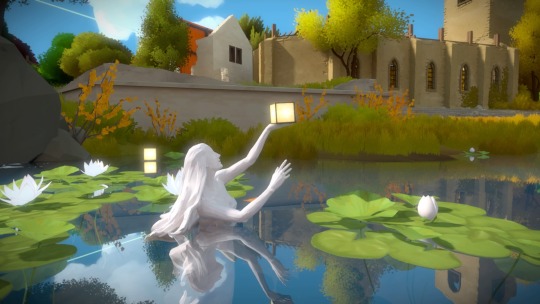
[no spoilers... this game would be nearly impossible to spoil in text]
Where do I even start?
I guess one thing to know about The Witness is that you can watch the famous 9-minute tracking shot from Nostalghia - where Oleg Yankovsky tries to walk a candle from one end of a drained pool to the other without extinguishing it - in its entirety. (I think it’s the entirety, I left before the clip was over; yeah, Jon, I get it.)
How do we interpret this? I haven’t watched Nostalghia, but I know that scene. Every film major knows that scene. Tony Zhou cited it in discussing lateral tracking shots, how they emphasize environment and create emotional distance from humans in the frame, and how Tarkovsky uses this to make the sequence lonely and arduous. Kyle Kallgren cited it in discussing how YouTube makes critique of certain types of art difficult, and Content ID essentially decides for us what film as a medium is even for.
Jon Blow plays the clip in full with no commentary - or, rather, the game itself is the commentary. There’s a sequence in Indie Game: The Movie where Jon Blow expresses some pain about how his game Braid was received, how he felt no one who played it ever really understood everything he was trying to say with it. That feeling might be ameliorated if he weren’t such a constituionally obtuse motherfucker.
Perhaps the scene is meant to draw parallels between Yankovsky’s dedication to a task that is simple yet difficult and the game’s puzzles, built, as they are, around complexity-through-simplicity. Except, Yankovsky’s Andrei has a personal investment carrying this candle, one Tarkovsky has spent the entire film setting up. I was about five hours into The Witness when I found this clip - more than twice the duration of Nostalghia - and I still didn’t know why I was solving the game’s puzzles or what they were trying to communicate.
Perhaps the scene is meant to draw parallels between the patience it encourages in its audience and the calm, meditative mode all The Witness’ allusions to Buddhism are seemingly on about, to give yourself over to the time investment the game demands of you. Except, Nostalghia asks you to spend nine minutes thinking about one thing; zen Buddhism encourages you to think of nothing; The Witness asks you to spend between fifteen and forty hours thinking about a zillion things. It is not a game about clearing your mind, it’s about filling your mind up. There is little continuity between the thoughtless peace of meditation or Yankovsky’s emotional collapse and the game’s intended “aha” moments.
But the ambiguity, the contextlessness of the scene’s inclusion, means you can’t be sure whether it’s contradictory. If we assume it’s about dedication, and we find a flaw in that worldview, maybe the problem is that we didn’t assume it was about meditation. And vice versa. If it fails to communicate, maybe the problem is us.
The only thing this scene communicates for sure is that Jon Blow wants me to know he watches Tarkovsky.
Jon Blow wants you to trust he knows what he’s doing. That the game is saying something. He also never, ever wants to tell you what it is. (If he could just tell you, he wouldn’t have spent eight years making it into a game, I suppose.) But this operates on completely opposite rules to the puzzles. Puzzles in The Witness are maze-drawing panels with increasing numbers of rules, all conveying their rules nonverbally, through gameplay. You see a symbol you don’t recognize, or a shape you don’t know how to draw, and you try things out, you make assumptions, you fail repeatedly, and then something works, the panel lights up, and you know you got it right. Now you understand what the symbol means.
The theming doesn’t work that way. Whatever theory you have as to what the game’s about, there will be no moment of clarification. Blow has an incredible talent, in fact, for constructing imagery that is hilariously blunt yet still ambiguous. As with Braid, where he crammed a straightforward narrative about memory and regret with allusions to quantum physics and the atomic bomb, The Witness references Einstein, the Buddha, Richard Feynman, romantic poetry, tech culture, game design, and - most of all - itself.
I realize I’m dancing around the subject here, because what the gameplay is (or isn’t) in service of is far easier to talk about than the gameplay itself. The Witness is a big island full of touch screens where you draw lines on grids. That’s it. The island is dense with structures and biomes, impossibly having a desert, a swamp, and three different kinds of forest which appear to be in four different seasons. What it doesn’t have is any reason why you’re there or a justification for solving ~600 line-drawing puzzles other than because Jon Blow wants you to. I was wrong in my video from 2015 to call The Witness narrative-based; the game contains narrative but it is not a narrative game. The island is very pretty, meticulously crafted, and not trying in the slightest to look like a real place. It is Myst minus everything people like about Myst.
Absent a reason for my character - if I’m even playing a “character” - to solve the puzzles, why am I, the player, solving them? The short answer is, “Because they’re there. You knew what you were buying. You solve the puzzles because it’s a puzzle game, do I gotta draw you a diagram?” (No, you need me to draw 600 diagrams.) That is unsatisfactory because the island is clearly more than an elaborate menu system.
Do I solve them because they’re interesting? I mean, they’re not bad, if you’re into Sudoku or, like... cereal boxes. In and of themselves, they’re not my cuppa. People told me about a repeated sense of epiphany the game provoked for them, but that’s not the way I experienced it. Every puzzle is so carefully tutorialized that I never felt I was making an intuitive leap. There is no lateral thinking in The Witness, it is strictly longitudinal. You get a row of puzzle panels, and you take them one by one (you are, in fact, prevented from jumping ahead), each one building on what it taught you. And they get hard, certainly, but each is the logical progression of the one before. And each is a marvel of nonverbal communication, but that’s more Jon being clever than it is me. This is not to judge people who did get a feeling of discovery; one person’s “aha” moment is another’s “yeah, Jon, I get it.”
(Aside: I did get a proper “aha” moment when I came to a panel that could be solved two ways. It controlled a moving platform; draw one line, the platform moves right, draw the other and it moves left. And I thought, “Huh, I guess I get it, but those shapes seem kind of arbitrary.” But then, while it was moving, I realized the platform itself mirrored what I had drawn; the two designs were what shape the platform would take when connected with each endpoint! And I went “oh fuck, oh fuck, that’s clever, that‘s really clever.” My first epiphany. It was the most Myst-like the game got, it was clearly not the kind of experience Jon Blow was interested in recreating much, and it took place 7 hours in.)
Do I solve them because I’m compelled? In the first play sessions, I asked myself several times, “Do I even like this?” The game is often tedious and frustrating and I regularly muttered “fuck off, Jon.” But I kept playing. I got annoyed when people interrupted me. I got a hideous case of Tetris effect. They’re not the kind of puzzles you can spend the day thinking through, like you would with Myst or Riven; they’re too abstract to visualize without them right in front of you. And the world is pretty but it’s not a place I wish I could visit, like I would with, again, Myst or Riven. But I kept going back. I solved puzzles less because I found pleasure in finishing them than I found displeasure in them being unfinished. Jon Blow has given talks on how game design focused on being “addictive” is basically evil - his word, not mine. And yet... it felt more like I was playing his game because I was hooked than because I was enjoying myself.
Do I solve them because I trust Jon Blow? Because I believe this will all amount to something? Jon certainly expects me to trust him. The game blares PROFUNDITY AHEAD constantly. (I remind you it quotes the Buddha.) But, in the years since Braid, I have grown less impressed with Jon Blow’s “art game genius” shtick. One fun bit about playing The Witness so late is finally reading all the discourse, and, well before finishing the game, I had read the thoughts of Andrew Plotkin, and Liz Ryerson, and Andi McClure - all of whom are brilliant - so I had a pretty good idea of what I was getting into. What’s surprised me is, having gotten to the first ending - not the secret ending - what the game is up to still isn’t clear. There are enough allusions to heady ideas that you can infer some stuff, but the default ending - while pretty enough - adds nothing and reveals nothing. And getting the True Ending means completing the In the Hall of the Mountain King section, something many will never find and precious few will ever complete. (Debating whether I’m going to even try.) If Jon Blow wants you to trust that he’s going somewhere with this, he makes you wait a long time before finding out if it’s worth it. [EDIT: turns out the secret ending comes after a different set of obscure puzzles than Hall of the Mountain King.]
Which leads me back to my original conclusion: I am solving the puzzles because Jon Blow told me to.
I suspect the arc Jon wants is for me to begin solving puzzles because I want to know what they’re in service of, what point Jon is trying to make, and then spend so long on them that I forget about the destination and just wrap myself up in the work, and, after dozens of hours on the hardest of the hard puzzles, Jon will finally reveal that the point he was making was about the labor I have just done. That he couldn’t tell me what it was for until I’d already done it. That the labor was its own reward. And how much you like The Witness is going to depend on whether or not you feel ripped off.
The overall impression The Witness left me with was less of meditation than discipline. (I have joked that playing The Witness feels like being in a D/s relationship with Jon Blow and not knowing the safe word.) Jon presents a simple concept and then expects you to solve every. single. permutation. of that concept. You do the work to find out what it’s about, and then what it’s about is the work. That game is about itself. The subject of The Witness is solving The Witness. It’s about purity of design, about simplicity, about slowly mastering a set of skills. (That these skills are neither inherently pleasurable to perform nor applicable in any other context seems not to matter; the point is, you learned them.) It’s hard not to read a game fixated on the beauty of its own design as all kinds of smug.
I allowed myself to be spoiled on the True Ending, and it seems, in the eleventh hour, if you draw lines til your fingers bleed, the game makes room for self-critique, questioning whether all this dedication to design actually is, in any way, meaningful or useful to us. Which, just a little bit, smacks of an artist spending two years making a sculpture of himself, chiseled to make him look a perfect Olympian beauty, only to label it “EGOISM.” Ooo. Make you think.
I suspect, in the end, I played it to (partial) completion because I was curious. I didn’t necessarily buy Jon Blow’s hype, but his hype is intriguing. As a portrait of a certain mindset, a monomaniacal obsession with design for design’s sake, the folk-religion of salvation through technology, and the critique of same, it is fascinating. I know people - smart people - who genuinely love this game, and, if the above is any indication, I clearly love talking about it. I have no regrets.
But, word of advice: if you don’t a) love the puzzles, or b) love the discourse, just walk away. Everything will be fine.
65 notes
·
View notes
Text
Reading A Poem
Introduction:
Commonly you should read a poem with;
With no particular expectations
Read with a open mind
Look up words that you don’t know
Decide how the poem should be spoken.
Paraphrase and summarize the poem.
Vocab:
Image- A word or a series of words that refers to a sensory experience
Irony- A discrepancy of meaning is covered under the surface of the language. When the writer says one thing but means something the opposite.
Verbal Irony - The discrepancy is contained in words.
Situational Irony- The discrepancy is shown when something is about to happen to a character or characters who expect the opposite outcome.
Diction- Word choice. The class of words that the author decides is appropriate to use in a particular work.
English Sonnet or Shakespearean Sonnet- A rhyme scheme organized into the quatrains with a final couplet: abab cdcd efef gg.
Closed Couplet- Two rhymed lines which contain an independent and complete thought.
Closed Form- Poetry written in a preexisting pattern of meter, rhyme, line, or stanza.
Haiku- A Japanese verse form that has three unrhymed lines of five, seven, and five syllables. Often serious and spiritual in tone and relaying on imagery.
Imagery- The collective set of images in a poem or other literary work.
Meter- A recurrent, regular, rhythmic pattern in verse.
Rhyme- The pattern of stresses and pauses in a poem.
Stanza- Recurring pattern of two or more lines of verse, the organizational principal of most formal poetry.
Simile- A comparison of two things, indicated by a connective, using like, as, and than.
Metaphor- A statement that one thing is something else, creating a close association between two things.
Myth- A traditional narrative of anonymous authorship that arises of a cultures oral tradition.
Narrative Poem- A poem that tells a story.
Lyric- A short poem expressing thoughts and feelings of a single speaker. Usually written in the first person Traditionally has a songlike immediacy and emotional force.
Motif- An element that recurs significantly throughout a narrative. An image, idea, theme, situation or action.
Theme- A recurring subject or idea conspicuously evident in a literary work.
Tone- The attitude toward a subject conveyed in a literary work. Playful, sarcastic, ironic, sad, solemn etc.
Verse- Refers to any single line of poetry or refers to any composition in lines of more or less regular rhythm.
Allegory- A narrative in verse or prose in which the literal events point to a parallel sequence of symbolic ideas.
Symbol- A person, place or thing that suggest meanings beyond it’s literal sense.
Subject- The main topic of a poem, story or play.
Style- The distinctive ways an author uses language to create a literary work.
* The purpose of a narrative poem is to tell a story
A lyric poem expresses thoughts and feelings a single speaker
Dramatic poetry presents the voice of a character speaking directly, without additional narration by the author
Didactic poetry is a poem that is to state a message or to teach.
The sound of a poem is an important element, to understand how that element helps to communicate the poems main theme.
Types of Meter-
* Iambic- An unstressed syllable followed by a stressed syllable
* Anapestic- Two unstressed syllable followed by a stressed syllable
* Trochaic- A line made up of trochees, a stressed syllable followed by an unstressed syllable
* Dactylic- One stressed syllable followed by two unstressed syllables
Iambic Pentameter- A line of five iambs, a meter familiar, it occurs in all blank verse, heroic couplets, and sonnets
- Often the sonnet changes direction
* Identify the moment when the poem “turns” - helps in understanding both it’s theme and the structure
* Study the poems opening
* Read the poem from this opening perspective until you feel it turning in another direction.
Writing-
Plan; give yourself time, choose a subject you care about
Know your purpose of your poem
Think about your audience
Discover your ideas
Brainstorm
Cluster- build a diagram, explore the relationships among your ideas
-Make lists
-Free-write
-Outline
(just to help get started..)
2 notes
·
View notes